Yachting Monthly
- Digital edition


Wow, that was fast! Why trimarans are SO much fun to sail – and how to do it
- Theo Stocker
- February 13, 2024
For their size, trimarans can punch well above their weight in speed, cruising potential and fun. Monohull sailor Theo Stocker gets to grips with how to handle one
Humans tend to gravitate into tribes of like-minded enthusiasts, enjoying the encouragement, support and sense of identity, while often looking askance at others; sailors at motorboaters, cruising sailors at racers, monohull sailors at raft, I mean, multihull sailors, and everyone looks askance at jet-skiers.
Large cruising catamarans (40ft now counts as a small one) are a world apart from monohull sailing, but there’s a sub-tribe of sailors dedicated to life on three hulls and builders such as Dragonfly, Corsair, Farrier, and Astus give them plenty of choice.
I’ve been sailing a 22ft (7m) Astus 22.5 this season, with just enough space for a family of four and a minimum of creature comforts. Thanks to her VPLP-designed hulls and 650kg all-up weight, we can sail upwind at 7-plus knots and downwind at over 10 knots with ease, all on a roughly even keel, while the kids play Duplo down below. It can also be beached and is towable behind a car.
Having, it seems, caught the trimaran bug, I wanted to get better at sailing and handling the boat, but my monohull sailing experience and habits were proving something of a hindrance, so we sought advice from some existing trimaran owners, and well as the UK’s top multihull sailors.
Much of the advice will apply to all multihulls , whether two or three-hulled, while other parts are just for small trimarans. I also found that brushing-up some of my rusty dinghy sailing skills helped get my head around what we were trying to do.
To try out our expert tips we went out sailing to see what difference they made. On the day, we got a solid Force 4-5 southwesterly, averaging 16 knots, but fluctuating between 12 and 20 knots true.
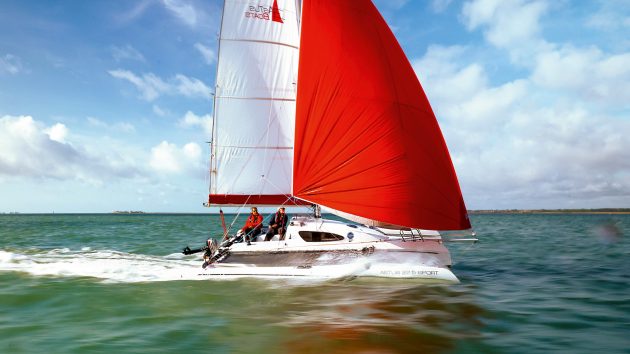
Blasting about on a sporty trimaran is a whole world of fun, but is much calmer than it looks
Trimaran sail trim
One of the biggest differences between a cruising monohull and a multihull is how the mainsail is trimmed. Leech tension on a yacht is often largely controlled by the kicker and the backstay, while the mainsheet sheets the mainsail in and out, predominantly controlling the angle of the boom to the centreline, and there may be a short traveller.
On a mulithull, however, there’s more than enough space for a good, wide traveller. Those who sail on performance monohulls will also be used to this. The sail shape is mainly controlled by the mainsheet, and the traveller then moves the boom towards or away from the centreline.
This is exaggerated on a multihull which has wide shrouds, swept well aft with no backstay, making space for a powerful square-top mainsail with full-length battens. There’s no backstay to bend the mast and flatten what is anyway a pretty rigid mainsail.
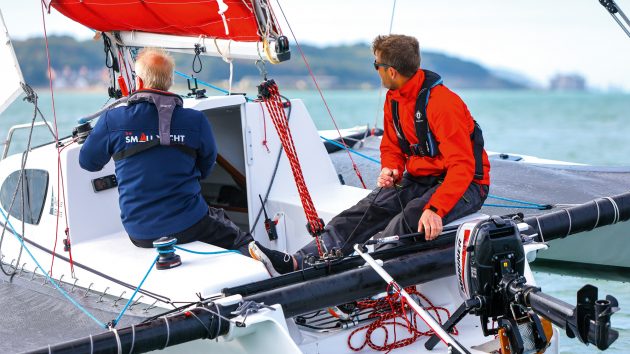
The mainsheet purchase creates enough power to control the leech of the square-top mainsail
Depowering a trimaran
Sailing on a monohull, heel and weatherhelm and eventually a broach give loads of warning that you’re pushing too hard. With straight hulls and little heel, those warning signs don’t really apply to multihulls.
In reality, however, there are a host of warning signals that it’s time to back-off; they’re just a bit different. Even then, there’s still a large safety margin before you get close to danger.
By way of reassurance, with the boat powered up on a beat, Hein, from Boats on Wheels, the boat’s owner, stood on the leeward hull and lent on the shrouds. Even as his feet got wet and the wind gusted at the top of Force 4, the boat didn’t bat an eyelid, thanks to the huge buoyancy of the floats.
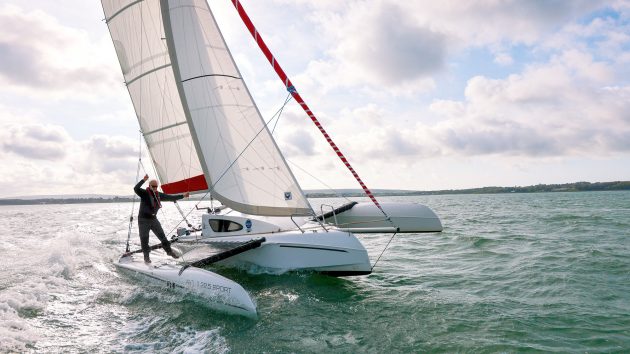
Even with a person on the leeward float the boat was extremely stable
On the water – sail trim
My first inclination was to point the boat as high upwind as possible, pin the sails in and go for height. Doing that resulted in a not-terrible boat speed of 5-6 knots and a good pointing angle.
Free off by a handful of degrees however, and ease the sails just a smidge, and the speed leapt up to 8-9 knots – over 50% more; a huge increase. So, don’t pinch. If you had a decent chartplotter on board, you could find your optimum speed to angle using velocity made good (VMG).
I was also tempted to pinch in the gusts, but it’s better to hold your course and let the speed increase until the main needs easing.
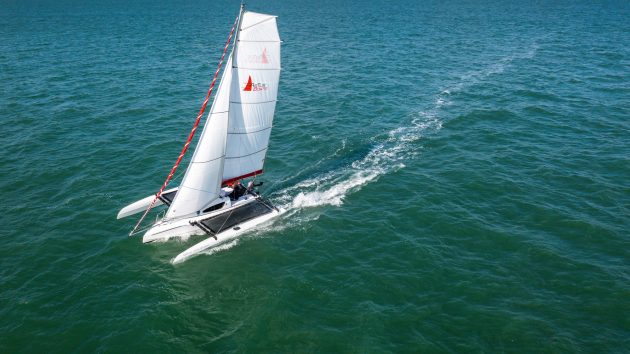
On the wind, it’s time to get the boat fully powered up
If that’s the case, drop the main down the traveller an inch or two or ease some twist into the mainsail and it makes all the difference in the world, but not so far that the top battens fall away and invert – that really isn’t fast. Push too hard and the boat will slow down, largely from the drag of submerging the leeward float and crossbeams. If you’re still overpowered and the main is luffing, it’s time to reef. Downwind is different, but we’ll get onto that later.
After we put a reef in the main, our boat speeds upwind remained largely the same, and the boat was much happier. I came away feeling reassured that even a little trimaran like this would be pretty difficult to capsize, and there were always plenty of warning signs telling me to take my foot off the pedal a little.
Article continues below…

Catamaran sailing skills: Mooring and anchoring a multihull
How do you make an average passage speed of 7 knots, fit in three double cabins and a huge saloon…

Monohull or multihull: which is best for blue water?
As former editor of Yachting World, David Glenn has plenty of experience of both monohull and multihull cruising. Here he…
Tacking and gybing a trimaran
Everyone knows that multihulls don’t tack as well as monohulls. Straight hulls and wide beam don’t lend themselves to turning, especially when coupled with the displacement and fixed keels of big cats. Trimarans are a little easier, with a single central daggerboard to act as a pivot, and one or other of the floats will generally be clear of the water. On the downside, light displacement means that there isn’t much momentum to keep you going through the turn and plenty of windage to stop you.
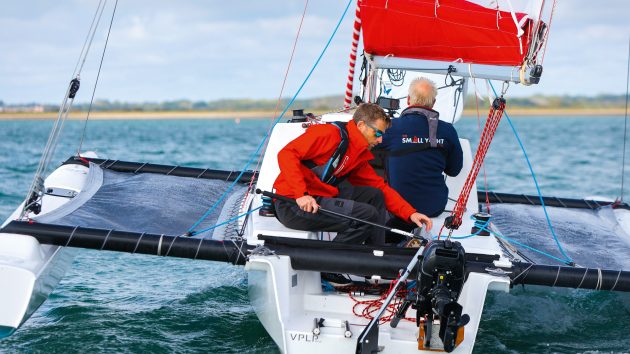
On a trimaran the central daggerboard helps the boat to turn by providing a central pivot point that catamarans lack
Speed is your friend. Build speed up before the tack to give you as much momentum as possible. The helm needs to steer positively into and through the turn, and if necessary, keep the jib backed on the new windward side to help the bow through the wind. Don’t worry about scrubbing speed off, but you don’t want to get stuck in irons.
When it comes to gybing, speed is again key. The turning bit isn’t going to be an issue as you’ll be scooting along, but the faster you’re going, the less load there will be on the sails. The more you slow down, the more the true wind will pile up.
Trimaran sailing skills
Tacks took a bit of practice. It felt plain wrong to jab the tiller across the boat, slamming a big break on in the water but I ended up putting us through the tacks far too slowly, losing a lot of speed. A more aggressive approach worked better. On the Astus, the traveller was between me and the tiller, so the tiller extension needed to be swung around the stern behind the mainsheet onto the new side.
Similarly, old habits of controlling a gybe needed to be modified. With the asymmetric set, we were planing at well over 10 knots, and the ideal is to stay on the plane. Heading dead downwind and centring the main lead to a more violent manoeuvre than flying into the gybe as fast as possible and, as the boom was never that far out thanks to the apparent wind angle, it didn’t need much extra controlling.
Coming up onto the wind after the gybe helped the asymmetric around the front of the jib and to fill on the new side. Stay too deep and it’ll get blanketed by the main. Once we had built up some apparent wind, we could bear away again.
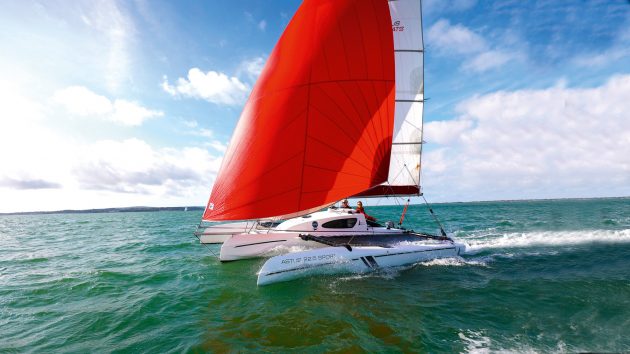
You’ll be on a course deep downwind before you know it, hitting speeds in the double digits
Downwind in a trimaran
Upwind cruising may be fun in a multihull, but bearing away and going with the wind is what it’s all about. Easily-driven hulls, a generous sailplan and light weight mean you can be up and planing, leaving displacement boats wallowing in your wake.
The big difference comes from apparent wind. If you’re in a boat that can do 15 knots downwind in 20 knots of true wind, the resulting wind angles can really mess with your head.
To get going then, says Brian Thompson, ‘Use those leech tell-tales again when sailing downwind and reaching to set the correct twist through the mainsheet, and use the traveller to set the correct angle of the whole sail to the wind.’
As the wind and your speed builds, bear away and trim the main accordingly.
In theory, you shouldn’t need to ease the traveller at all, but you may need to if you want to sail deep downwind. As the gust fades, you’ll find the boat slows down, so you can come back up towards the wind a little to pick up some more breeze, and then bear away as you accelerate again.

Bear away as the boat accelerates. Your course will be something of a slalom as you look to keep a consistent wind angle
This results in something of a ‘slalom’ course, and will also be accentuated if you’re sailing down waves, but that’s all quite normal for apparent wind sailing. Ultimately, you’re looking for a consistent apparent wind angle, even if the resulting wake isn’t straight.
It’s worth remembering that apparent wind reduces the felt effect of the wind, so you need a sailplan to suit the true, not apparent wind speed.
I found that the boat was more sensitive to having a balanced sailplan and trim downwind than upwind, largely because you’ve got almost double the canvas up, with the bowsprit as an extra lever. When weather helm built, I needed to ease the mainsheet to increase twist to depower so that I could bear away. I must admit, getting the boat balanced, sailing fast and light on the helm at 15 knots was something I came away feeling I needed more practice at.
Reviewing the images, I suspect the asymmetric was sheeted in too hard, with too much twist in the main.
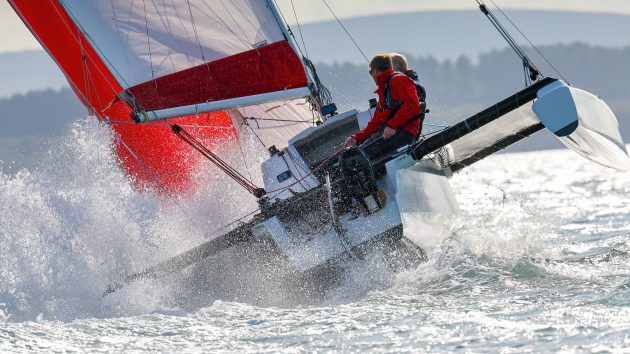
Getting a float fully submerged is when it’s time to back off
On the water
Unfurling the gennaker worked best on a beam reach, giving plenty of airflow over the sail to help it fully unfurl. This was also roughly the fastest point of sail, ideal for getting up some speed for apparent wind sailing. We mostly had the sails set for a close reach, even when we were beyond 120º off the true wind on a broad reach.
It was possible to soak deeper downwind, but lose the apparent wind benefit downwind and our speed dropped off dramatically, prompting us to point a bit higher to find some more speed.
As the boat powered up, it paid to hold a slightly higher angle than I would have done in a monohull for the boat to properly take off and get up into double digit speeds – topping out at 15 knots. Lymington to Cowes would have taken us just half an hour at that speed. It’s easy to give yourself a heck of a beat back!
We were sailing on a pretty flat day, so didn’t have to contend with any waves to speak of. On the recent RTI this is what caused the capsizes of at least two multis, a sobering reminder that you need to sail much more conservatively in lumpier conditions.
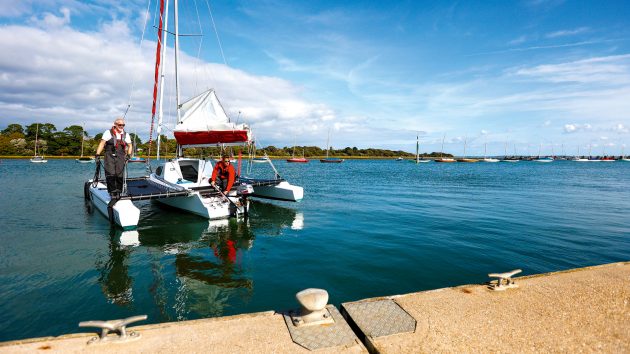
The bows want to point downwind, so a stern-first approach works with rather than against the boat
Coming alongside
A 650kg boat with no draught and plenty of windage feels dreadfully skittish when manoeuvring in confined spaces. Straight hulls with no forgiving curves and fragile-looking sharp bows make berthing tricky. You’ve got a couple of advantages on your side, however. In the Astus, the floats are at pontoon height making stepping off easy.
Whether you have an engine in each hull of a cat, or one in the central hull of a tri, there’s also a lot more leverage to play with to turn the boat and drive her on or off the pontoon. A steerable outboard gives you even more options.
If the boat has a lifting keel or daggerboards, put them down if there’s enough depth to give you a pivot and to resist drifting. Think about getting corners onto the pontoon, rather than putting the boat alongside. On tris, you won’t be able to get to the bow to fend off as it’s too narrow. You can rig a fender up forwards on a line, and two fenders are enough on the flat sides.
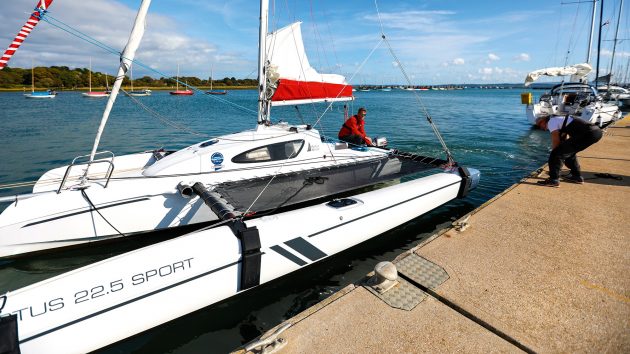
Steering with the outboard towards the pontoon will drive the stern in more; steer away to drive the bow in more
Offshore wind
Coming onto the pontoon with wind blowing off, it worked well coming in stern first. If there’s a tide running, you’ll want to be heading into the tide, so find a spot down wind and down tide to start your approach so you come in at an angle.
On our first attempt we had a bit of tide under us to start with so we came in at a much steeper angle, almost 90º, although this worked out OK in the end.
The crew could then step ashore, taking a line from the stern quarter round a cleat.
Drive forwards against the line and the bow will obediently drive up towards the pontoon, bringing you flat alongside. Getting off was simple, releasing the bowline, and allowing the bow to swing out the before slipping the stern line.
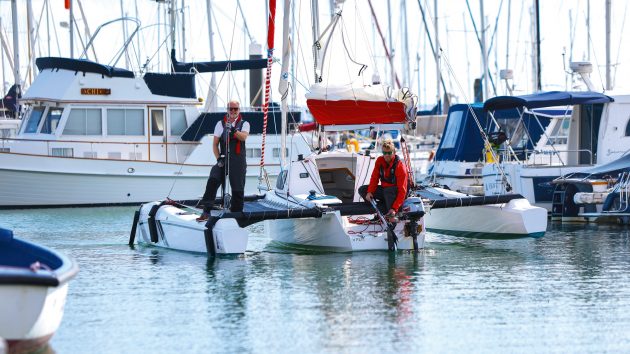
Coming in astern and stopping upwind of the berth meant the bows blew towards the pontoon far to quickly
Onshore wind
Getting onto and off a pontoon with onshore wind proved rather trickier. On our first attempt we came in stern first. The issue was that once we were just upwind of our desired berth and stopped, we lost steerage and the bow immediately blew off with alarming speed towards the pontoon.
Going ahead would only increase the force of the impact, while going astern only increased the bow’s sideways drift. I managed to back out without smashing the bow, but only just, and ended up awkwardly stern to the wind with the bows pointing at the pontoon.
On our second attempt we came in bows first but having aimed at the berth, I had to motor the stern to leeward to stop the bow hitting, making for a rather forceful coming alongside.
On take three, I came in forwards and began ferry gliding towards the berth early, keeping the bows to windward of the stern. Being able to steer with the outboard meant I could go ahead to keep the bow up, and go astern with the engine pulling the stern down toward the pontoon. In this way, it was possible to come in pretty well controlled and parallel to the berth.
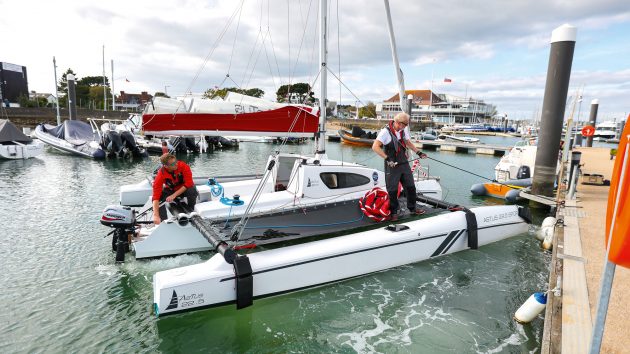
To get out, motoring astern against a bow line pulled the entire boat clear before slipping the line
Leaving was a different proposition all together, as I didn’t want to drag the bow along the pontoon, or to drive hard onto it to spring off. Instead, we rigged a slip-line from the forward cross beam. Going astern against this, and then turning the engine towards the wind, I could pull the stern, and the rest of the boat, out and away from the pontoon.
Keeping power on astern, once we’d reached a decent angle, we slipped the line and went astern, finding steerage way almost at once, with the bow following obediently in our wake with more control than I had anticipated.
Whether the wind is blowing onto, or off the pontoon, you want the engine to be driving or pulling the boat off the pontoon with a line on the corner you are going away from. That way you avoid point-loading fine ends where it’s hard to fender.
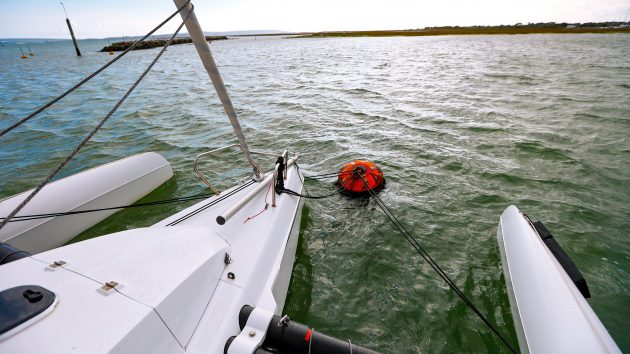
You’ll want a bridle to reduce swinging, but keep the pick up lines on the bow as backup
Anchoring and mooring a trimaran
While mooring a catamaran is complicated by the lack of a central bow, things should be simpler on a trimaran, and they are, mostly. Picking up a mooring buoy from the main hull bow with a low freeboard and dropping the pick-up line onto a cleat is easier even than a monohull.
The bow may be narrow, but for any lines that pass through a ring on the buoy, you still need to take it back to the same cleat to avoid chafe. That should be it, but windage from the two extra bows and the lack of keel mean the boat can dance merrily around the mooring buoy in a breeze.
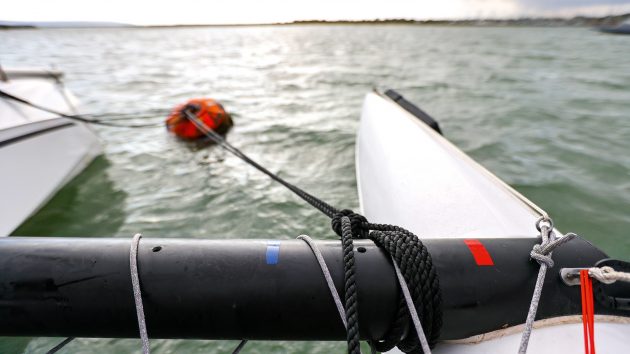
Rig the bridle so the buoy sits to one side to stabilise the boat
In practice, we found that a trimaran benefits from a mooring bridle in the same way that a catamaran does. It can’t be rigged from the floats’ bows, as there are no mooring cleats, so a line passed around the outboard ends of the forward beams gave a pretty good angle, again with long lines passed through the mooring and back to the same side. The main pick-up lines stay as a safety backup.
The other trick is to rig the bridle asymmetrically so that the buoy sits to one side or the other, just enough to not be dead head to wind, making it much more stable in the wind.
On the plus side, the lack of draught or keel means that you’ll nearly always be lying head to wind, so the cockpit remains nice and sheltered whatever the tide’s doing.
We ran out of time on the day to try anchoring, but rigging a bridle, effectively a long snubber to a point on the anchor chain in a similar way wouldn’t be tricky.
If you needed not to swing, or to behave more like deeper boats nearby, hanging a bucket over the stern can help, or there’s always anchoring with a kedge, either out ahead in a V, or in line astern.
Enjoyed reading this?
A subscription to Yachting Monthly magazine costs around 40% less than the cover price .
Print and digital editions are available through Magazines Direct – where you can also find the latest deals .
YM is packed with information to help you get the most from your time on the water.
- Take your seamanship to the next level with tips, advice and skills from our experts
- Impartial in-depth reviews of the latest yachts and equipment
- Cruising guides to help you reach those dream destinations
Follow us on Facebook , Twitter and Instagram.
Log in or Sign up
You are using an out of date browser. It may not display this or other websites correctly. You should upgrade or use an alternative browser .
Theoretical hull speed for VERY NARROW hulled trimaran.
Discussion in ' Powerboats ' started by Docta , Nov 26, 2008 .
Docta New Member
Hey... I've been looking for some information lately on theoretical hull speeds on very narrow aspect ratio hulls, and cant find any good info. I have built one boat in the past, a flat bottomed fishing catamaran, with decent results for the flats and rivers and am looking now for a project to get me offshore and slice through decent chop on my may to the backwaters I want to build an 8 foot beam 22 foot long full displacemt power boat, riding on three VERY narrow hulls, 8" a piece should give me as much float as I need, leaving a L:B ratio of about 33:1; kind of the same concept as the glacier bay boats, but a bit more extreme and with no "planing section" over the displacement portion of the hull.--- all of the hull speed calculators I can find do not calculate hull speeds for very narrow hulls... and predict this boat wont break 8 knots. I was hoping somebody might be able to give me a reliable estimate of the theoretical hull speed of such an arrangement, and a reasonable estimate of the power needed to get three of these hulls to theoretical maximum hull speed and how many HP in particular Ill need to get to my target cruise speed of 20 knots. I am hoping for 20 knots at 60-75 HP in real world conditions, and I think this should be achievable but I want solid numbers before moving forward. Loaded at fishing/boating weight, I am assuming a total wet displacement of 2500#. THanks in advance for any help or info you could provide!
Guest625101138 Previous Member
Hull speed is a defined parameter related to the celerity of the transverse wave group formed by the hull that has the same wavelength as the water line length of the hull. It was coined a long time ago when it was determined that heavy displacement hulls found it difficult to exceed the so-called hull speed unless they had very high power. In deep water the celerity of a wave train is given by: V=sqrt(g x Wavelength / (2 PI)) (g is gravitational constant 9.8m/s/s) A long slender hull has relatively low wave drag compared with viscous drag so the notion of hull speed does not apply. The detail provided so far gives you a starting point for a design. Maximum length 20ft. Overall beam 8ft. Target speed 20kts. You need to make an estimate of the overall weight as this will be critical. You can use some free software Michlet/Godzilla that will give you an optimum for any configuration. I am not sure if 3 equal size hulls will give the lowest drag but it worth investigating. I know that a monohull will not give the lowest drag at that speed and length. Rick W
terhohalme BEng Boat Technology
Check this: http://www.ctcnederland.nl/texelrating2007eng.htm There is an calculator for reference. http://www.ctcnederland.nl/easy calculator example.xls
- Advertisement:
PortTacker Junior Member
Two things - if the mainhull is very narrow, that's a pretty heavy motor you're contemplating. You'll waste half the power overcoming its own weight. Based on performance I've seen over the years - I'd say if you keep the hulls narrow and shape them for low drag, keep windage to an absolute minimum and keep the boat light - at 22x8 feet you should easily be a ble to hit the 20 knots cruise with 30hp. You might contact Mike Leneman at Multimarine.com - he's played with this concept with great results.
High Speed Smooth Fuel Efficient Hybrid Hull?
LDL Hull Scandinavian Designer
RibCat680 Twin Hull Rigid Inflatable
Planing catamaran vs planing mono hull vs displacement cat fuel 8kts
Designing and building small tunnel hull powerboat
Guesses on hull speed? 21' Unknown Design
Wide mounted twin outboards on monohull
Moment to trim question on hull extension
Aqua Lark hull repair
Single inboard hulls that surf well - 24-27 ft range
- No, create an account now.
- Yes, my password is:
- Forgot your password?

Tri Hull Boat Models: Specs, Prices, and Competitors Explained
Tri-hull boats, also known as trimarans , have been gaining popularity in the boating world due to their unique design and performance capabilities. These boats come with three hulls, which provide stability, speed, and additional space on the deck compared to traditional monohull boats.
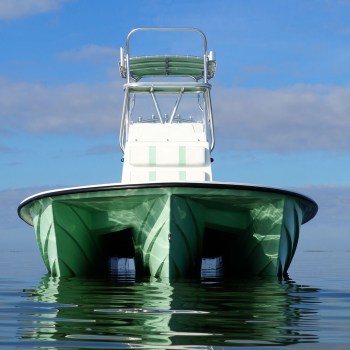
Several manufacturers offer a range of tri-hull boat models designed for different purposes and varying budgets.
As a boating enthusiast, I've noticed an increasing demand for tri-hull boats and have decided to dive deeper into this topic. Throughout my research, I have explored various models, specifications, and price points to understand the key factors that contribute to their performance and how they stack up against their competitors.
From leisurely sailing to high-performance racing, tri-hull boats cater to a wide range of users and preferences.
Key Takeaways
- Tri-hull boats offer stability, speed, and spacious decks due to their three-hull design
- Models and specs vary among manufacturers, catering to different budgets and needs
- Tri-hull boats face competition from other boat types, emphasizing the importance of comparative analysis
Overview of Tri-Hull Boats
History and Evolution
Tri-hull boats emerged in the 1960s as a popular design choice due to their increased stability, more deck space, and smoother ride on the water. They were initially used in smaller recreational boats, but eventually, the design found its way into larger ferries and warships as well 1 .
Basic Design and Structure
As the name suggests, a tri-hull boat features three hulls at its base, providing extra stability compared to other designs like monohulls and catamarans.
The main hull runs down the center of the boat, with two sponsons (smaller hulls) on either side, extending all the way to the bow. These sponsons add buoyancy and width at the bow, increasing the interior volume of the boat 2 .
In essence, a tri-hull boat combines the best features of a deep V-hull with the stability of a tunnel hull design, making it a versatile choice for various boating needs.
Some popular tri-hull boat models include the Farrier F22 Trimaran, which offers speed, compact size, and high-performance in its various series, such as the F-22, F-22S, and F-22R 3 .
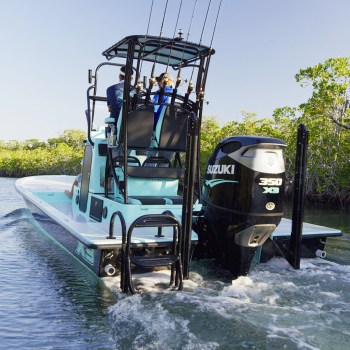
Tri-Hull vs Other Hull Types
When comparing tri-hulls to other hull types, there are a few key differences to consider:
- Stability : Tri-hull boats offer superior stability over monohulls and catamarans due to their three-hull design; this makes them a popular choice for recreation and fishing activities.
- Deck Space : The tri-hull design offers more deck space compared to other hulls, making it easier to accommodate passengers and gear 4 .
- Ride Comfort : Thanks to the added buoyancy at the bow, tri-hulls provide a smoother and more comfortable ride on the water, especially in choppy conditions.
- Speed : While not as fast as some multi-hull designs, tri-hull boats can achieve higher speeds due to their deep V-hull and tunnel hull characteristics.
- Boating Geeks ↩
- Boatsetter ↩
- ExploOcean ↩
Design and Specifications
Hull Design and Materials
The tri-hull boat design features three hulls: a central hull with two outer hulls called sponsons .
Commonly made from fiberglass , these boats offer a unique combination of stability, buoyancy, and good performance.
The use of fiberglass not only adds strength and durability to the hull but also results in a relatively lightweight construction. This allows for better power-to-weight ratio and thus, better overall handling and acceleration capabilities.
Deck and Space Allocation
One of the biggest advantages of tri-hull boats over traditional ones is the extra deck space that the three-hull structure provides.
The wide beam created by the sponsons offers a spacious and stable platform , making these boats an ideal choice for various activities like fishing, cruising, and watersports.
Here are some key features of a tri-hull boat's deck and space allocation:
- Spacious open deck for easy movement
- A wide platform that provides stability in various water conditions
- Ample seating and storage space
- Room for adding fishing, cruising, and watersports accessories
Performance Factors
When it comes to performance, tri-hull boats offer a unique blend of stability, speed, and power.
Their design allows them to maintain a more level position on the water when picking up speed, which reduces drag and optimizes performance.
Here are some main performance factors to consider for tri-hull boats:
- Stability : The three-hull design gives a wide base that aids in keeping the boat stable, even in rough water conditions.
- Speed : Tri-hull boats are generally not as fast as comparable monohull boats; however, they still provide decent speed levels for various activities.
- Weight : The use of fiberglass in hull construction results in a lightweight boat, thereby increasing the overall power-to-weight ratio.
- Sailing : Tri-hull sailboats like trimarans provide a stable sailing experience even in stronger winds due to their inherent design.
- Power : Due to a more level position on the water, tri-hull boats require less power to maintain their speed.
Types of Tri-Hull Boats
Recreational Tri-Hulls
Recreational tri-hull boats are perfect for those who enjoy spending time on the water with family and friends. These boats offer plenty of space for seating, storage, and activities.
Tri-hull pontoon boats are a popular choice for recreational boating due to their stability and spacious decks.
Another option is tri-hull deck boats, which can comfortably accommodate larger groups. These boats are designed for a smooth, stable ride and are great for cruising or water sports.
Fishing Tri-Hulls
For anglers, fishing tri-hull boats are a practical choice. These boats have the extra stability of a tri-hull design, making them ideal for fishing on lakes, rivers, and even coastal waters.
Bass boats, in particular, are popular tri-hull fishing boats, providing a stable platform with ample storage for fishing gear and increased deck space . This design allows fishermen to move around the boat easily while casting and retrieving their lines.
High-Performance Tri-Hulls
For those seeking speed and excitement, high-performance tri-hull boats are the way to go.
One example is the Farrier F22 Trimaran , a versatile, compact sailboat that comes in three series: the F-22, F-22S, and F-22R. These series are categorized as standard, standard premium, and premium models, respectively.
Tri-Hull Boat Models and Specifications
As a fan of tri-hull boats, I appreciate their unique design and stability on the water. Tri-hull boats offer more space and better fuel efficiency compared to similar-sized monohulls.
When it comes to models and specs, there are several notable tri-hull boat options in the market that cater to distinct needs and preferences.
The Farrier F22 Trimaran is a versatile and high-performance boat , available in three series - F-22, F-22S, and F-22R. These are categorized as standard, standard premium, and premium models, respectively. This trimaran is compact and known for its speed, making it an excellent choice for sailing enthusiasts.
One of the popular tri-hull boat manufacturers, Bennington , offers a wide range of pontoon and tritoon boat models. The New 2024 Bennington R Line ranges from 23 to 27 feet in length and 8.5 feet in width.
These boats are highly customizable, with outboard single engine options up to 450 HP, outboard twin engine options up to 600 HP, and an I/O (sterndrive) option up to 430 HP.
Harris Boats is another brand offering stunning tri-hull boat models for 2023. Their Standard package includes two 25" diameter tubes, a full-length keel, reinforced nose cones, rear skin kit, and a 28-gallon fuel tank.
These boats come in varying lengths and are available in different models like Grand Mariner, Solstice, Sunliner, and Cruiser.
A performance-oriented and foldable option is the Corsair Trimaran , which is known for its foldable amas. These boats offer incredible speed and reliability, making them perfect for racing and fast cruising.
Price Analysis
Price Range and Factors
In my research, I found that the price of tri-hull boats can vary significantly based on various factors such as size, model, materials used, and additional features.
For instance, the Farrier F22 Trimaran comes in three series: F-22, F-22S, and F-22R, which the maker categorizes as standard, standard premium, and premium models, respectively.
When it comes to materials, both construction and finishing play a role in determining the price.
Boats made of more advanced materials like fiberglass or carbon fiber tend to be more expensive than those made of aluminum, for example.
Additional features like electronics, sails, and rigging can also impact the final cost.
I also came across the Neel 51 Trimaran , which boasts impressive specifications like a 15.60m (51ft) LOA, 8.9m (29ft 2in) beam, and 1.50m draught. Although the specific price was not mentioned, it's safe to assume that boats like this fall into the higher end of the market.
Cost of Ownership
The overall cost of owning a tri-hull boat goes beyond the initial purchase price. One should also consider the expenses related to maintenance, storage, insurance, and potential repairs due to damage or loss.
- Maintenance : Similar to other boat types, tri-hull boats require regular upkeep, including cleaning, painting, and engine servicing, to ensure their longevity. These costs will depend on factors like boat size, material, and geographic location.
- Storage : Storage options for tri-hull boats include marina slips, dry storage, and mooring, with varying prices based on location and the type of storage chosen.
- Insurance : Boat insurance can help cover potential loss or damage costs. However, the rates will vary depending on the value of the boat, location, and the coverage chosen. To mitigate risk, always remember to adhere to safe boating practices .
- Repairs : Any damage sustained during regular usage or incidents should be factored into the cost of ownership, as repair costs can accumulate over time.
Comparative Assessment
Tri-Hull Boats vs Competitors
When comparing tri-hull boats with other boat types, it is essential to examine the strengths and weaknesses of each.
Tri-hull boats are known for their stability, spaciousness, and shallow draft, making them a popular choice for recreational and fishing activities.
One popular tri-hull boat model is the Farrier F22 Trimaran , which offers speed and versatility.
In contrast, V-hull boats provide better handling and fuel efficiency but may be limited in terms of deck space.
For instance, pontoon boats offer similar stability to tri-hull boats and a spacious deck but may lack the speed performance of V-hull boats or trimarans. However, pontoon boats are generally more comfortable and suitable for leisure activities.
Comparatively, catamarans and trimarans - both under the multi-hull category - share stability and spaciousness advantages with tri-hull boats.
The Neel 51 Trimaran is an excellent example of a three-hulled yacht that competes in the luxury market segment.
Here's a comparison table to help illustrate the key differences:
| Type | Stability | Spaciousness | Speed | Comfort |
|---|---|---|---|---|
| Tri-Hull | High | High | Moderate | Moderate |
| V-Hull | Moderate | Moderate | High | Moderate |
| Pontoon | High | High | Low | High |
| Catamaran | High | High | Moderate | High |
| Trimaran | High | High | High | High |
Market Positioning
In terms of market positioning, tri-hull boats are generally priced more affordably compared to their multi-hull counterparts like the catamaran or trimaran. This positions them as an attractive choice for budget-conscious buyers looking for stability and space.
Outside of recreational boating, tri-hull boats are popular among anglers, as their stability and spaciousness enable them to carry more equipment and provide a steady platform for fishing.
However, in the luxury market, catamarans and trimarans generally dominate, with options like the Leopard 42 catamaran offering more affordable options and the Neel 51 Trimaran targeting the high-end market segment.
Usage and Functionality
Cruising and Watersports
In my opinion, tri-hull boats are an excellent choice for recreational usage. Their unique design offers more space on the deck than other boats, which is a significant advantage for family outings, fishing trips, and watersports.
The added stability provided by the three hulls also ensures a more comfortable ride, especially for those new to boating.
Top models for these activities include the versatile Farrier F22 Trimaran , which comes in three series: the F-22, F-22S, and F-22R, catering to various preferences and budgets.
One notable aspect of the tri-hull boat is how it planes on the water, lifting the bow out and making the ride smoother. This feature provides a stable platform for fishing and watersports, particularly when you need to be at a standstill or maneuvering at lower speeds.
Commercial and Industrial Use
I have observed that tri-hull boats are not just limited to leisure activities but can also serve commercial and industrial purposes. In fact, these boats are often utilized as ferries in regions like Southeast Asia. Their stability and shallow draft make them well-suited for navigating shallow waters and carrying passengers.
Moreover, various navies around the world have tri-hull warships. These boats offer numerous advantages, including increased speed, reduced hull drag, and a more stable platform for weaponry and crew operations. For instance, the Leopard 42 is a popular tri-hull commercial vessel with impressive specifications, including an LOA of 12.67m, a beam of 7.04m, and a draft of 1.4m.
Advantages and Disadvantages
Performance in Various Waters
A significant advantage of tri-hull boats is their stability in various water conditions. The three hulls at the bottom of the boat provide a wider base, offering excellent balance, especially in choppy waters. However, this design may also result in a wet ride when facing large swells or rough waves, as the wide shape tends to cause water to splash up onto the deck.
In calm waters, tri-hull boats perform quite well, offering a smooth and stable experience for recreational boating, fishing, or water sports. This is primarily due to the center hull, which helps to lift the boat up on a plane, keeping it level as it moves across the water's surface. Nevertheless, tri-hull boats might struggle more in rough, turbulent waters, where their broad profile can lead to decreased agility and increased wobbling.
Comfort and Handling
The unique design of tri-hull boats maximizes the deck space available, making them great options for on-deck socializing, parties, or group activities. The wide beam and three hulls also contribute to a comfortable ride with minimal tilting or rocking, allowing passengers to move around with ease.
Handling-wise, tri-hull boats are generally easy to maneuver, especially at low speeds. However, as with any boat, handling will vary depending on the specific model and its features.
Tri-hull boats tend to have a shallower draft than other types of boats, meaning they can navigate shallow waters more easily. This benefit is most apparent when beaching the boat or maneuvering around tight spots near the shoreline.
On the flip side, when traveling at high speeds, these boats can experience some loss of stability and may struggle to maintain a smooth ride. Due to their wide design, tri-hull boats may have a larger turning radius than other types of boats, such as monohulls or catamarans. As a result, they might not be the best choice for those who prioritize agile handling and responsive control in extremely rough waters.
Innovations and Future Trends
As an avid follower of marine engineering and design, I see several advancements shaping the future of tri-hull boats. Trimarans are becoming increasingly popular due to their unique design, offering greater buoyancy and stability compared to mono-hulls. Innovations in folding systems, hull designs, and flotation materials have made these boats more versatile and appealing to boating enthusiasts.
A key innovation in the tri-hull boat industry is the development of efficient and user-friendly folding systems like those found in the Farrier F22 trimaran. These systems enable the boat to be easily trailered and stored, which is highly convenient for boat owners with limited space.
New hull designs for trimarans, such as flat hulls and tunnels, continue to gain traction as they improve the overall performance and stability of the boat. Tri-hull boats with flat-bottomed outer hulls provide added stability for the vessel and enhance its lifting capabilities on the water surface. Additionally, the tunnels created by the tri-hull design help reduce drag, which leads to increased fuel efficiency and speed.
The use of innovative flotation materials is another aspect that will shape the future of tri-hull boats. Lightweight materials with greater buoyancy are continuously being developed to improve the performance and reduce the overall weight of these boats, as seen in the Neel 51 Trimaran .
Frequently Asked Questions
What are the specifications and price ranges for popular tri-hull boat models?
Popular tri-hull boat models, such as the Farrier F22 Trimaran , come in different series like the F-22, F-22S, and F-22R. These models vary in terms of specifications, with some focused on compactness while others boast high performance. The price range for tri-hull boats can vary significantly depending on the model, size, and features, but generally, they can range from around $20,000 to well over $100,000.
How do tri-hull boats compare with other boat designs in terms of performance and stability?
Tri-hull boats are known for their improved stability, buoyancy, and larger deck space compared to monohulls and catamarans . This is due to their unique design, which features three hulls . The increased width at the bow provides a smoother ride in choppy waters. However, when it comes to speed, tri-hull boats may be slightly slower than their counterparts.
What are the leading manufacturers of tri-hull boats and how do their models differ?
There are several leading manufacturers of tri-hull boats, each offering unique models with different features, designs, and performance levels. Some of the top companies include Farrier Marine, Boston Whaler, and Grady-White. While each manufacturer offers a variety of models, they all focus on providing boats that cater to different boating needs, such as fishing, cruising, or water sports.
Can you list some current market competitors to tri-hull boats?
Tri-hull boats face market competition from other boat designs, such as monohulls, catamarans, and pontoon boats. Each of these alternative designs offers different advantages and drawbacks. For example, monohulls provide better handling in rough waters, while catamarans offer increased speed and fuel efficiency. Pontoon boats, on the other hand, are built for stability and comfort but may lack the speed of tri-hull designs.
How has the tri-hull boat market evolved over the past few years?
The tri-hull boat market has undergone various changes over the past few years, driven by advancements in marine technology and shifting consumer preferences. Advances in hydrodynamic design and construction materials have led to improvements in the performance and fuel efficiency of tri-hull boats. Moreover, manufacturers have also been focusing on incorporating features that cater to consumers' increasing demands for comfort and safety.
What should be considered when purchasing a used tri-hull boat?
When purchasing a used tri-hull boat, there are several factors to consider.
Some of the critical aspects include the boat's overall condition, inspection of the hulls for signs of damage or wear, engine performance, and the condition of the electronics and equipment on board.
Additionally, you should verify the boat's maintenance history, ensuring the previous owner has well-maintained and cared for it.
Related Articles

Marine Fire Extinguishers: 2024's Latest Life-Saving Tech Innovations

Top 10 Boats for Sale in Greensboro North Carolina: Ultimate Guide for Buyers
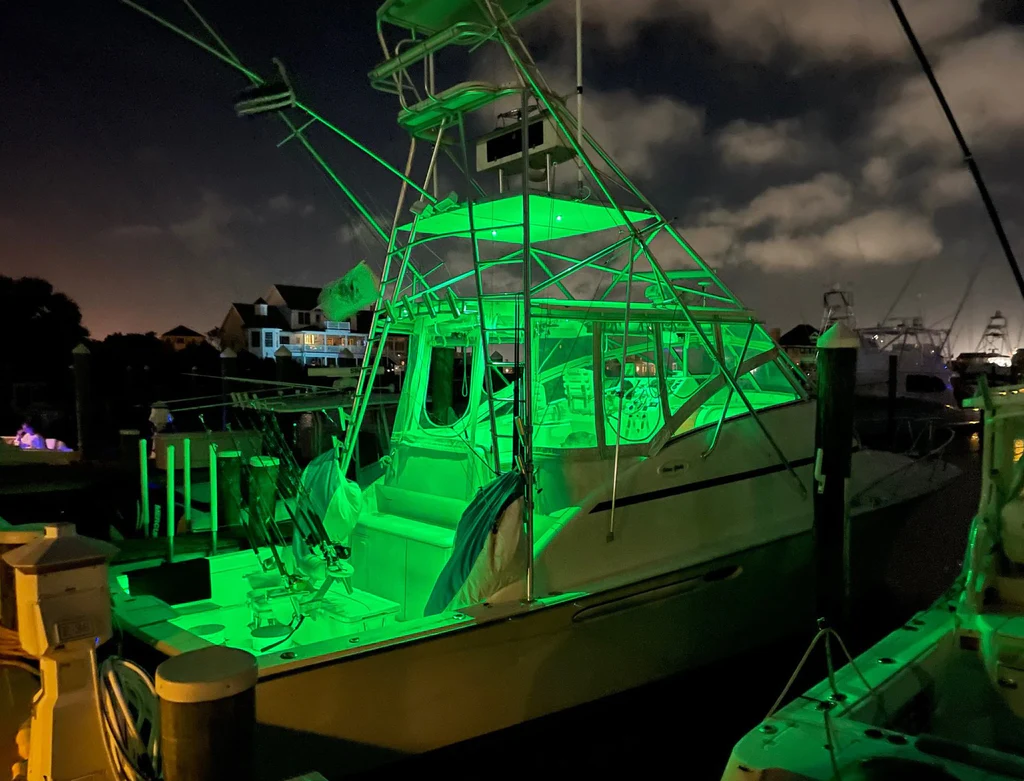
Black Oak LED: Unleashing Illumination Excellence
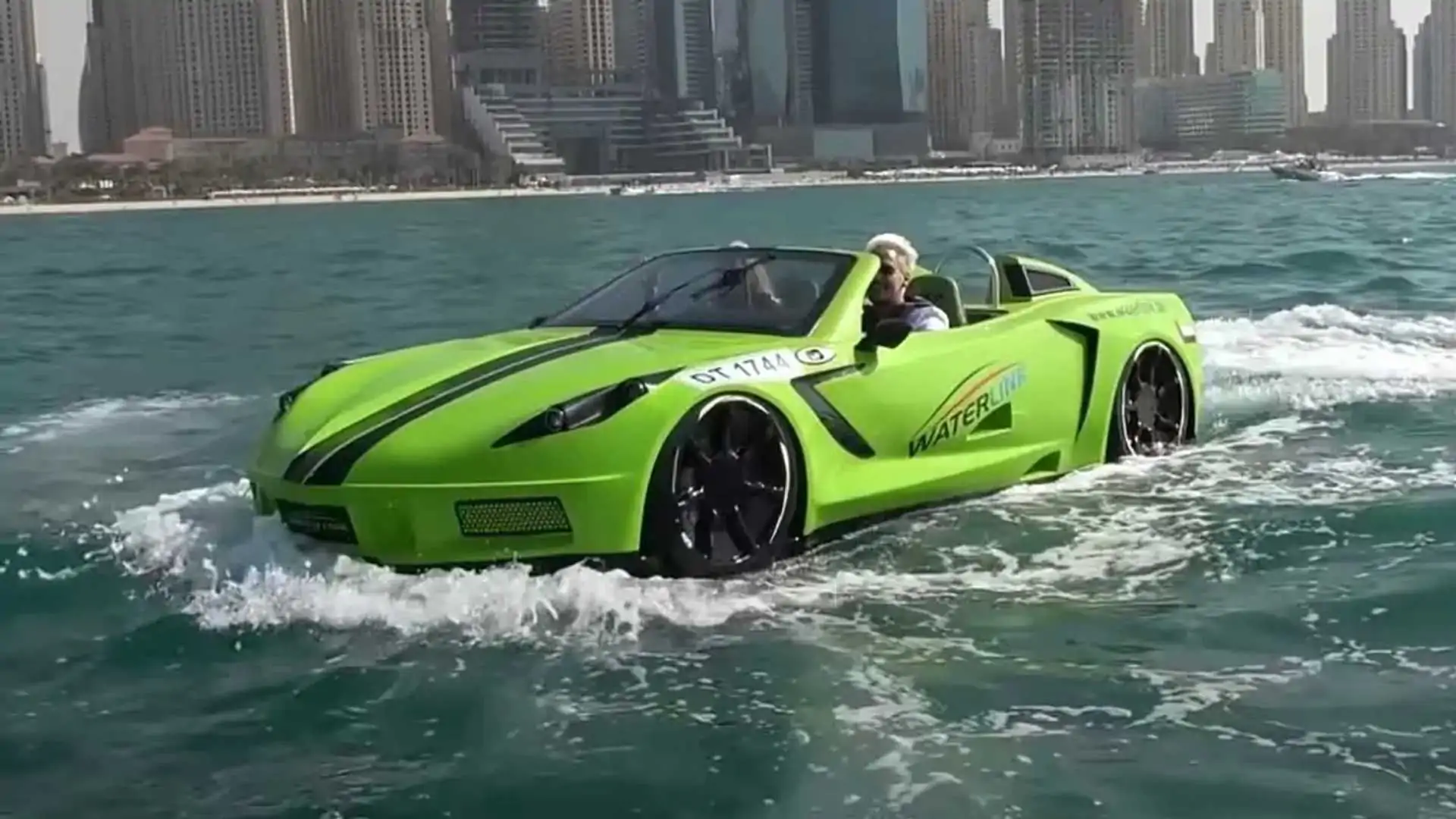
Corvette Boat: A Comprehensive Guide for Enthusiasts

SoFlo Boat Show 2024: Premier Marine Exhibition and Sales Event

Small Boats Ultimate Guide with Options: Navigate Your Perfect Choice
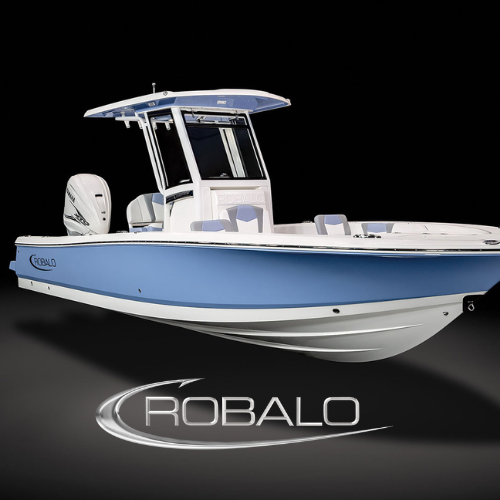
Robalo Boats: Unrivaled Performance and Luxury on the Water
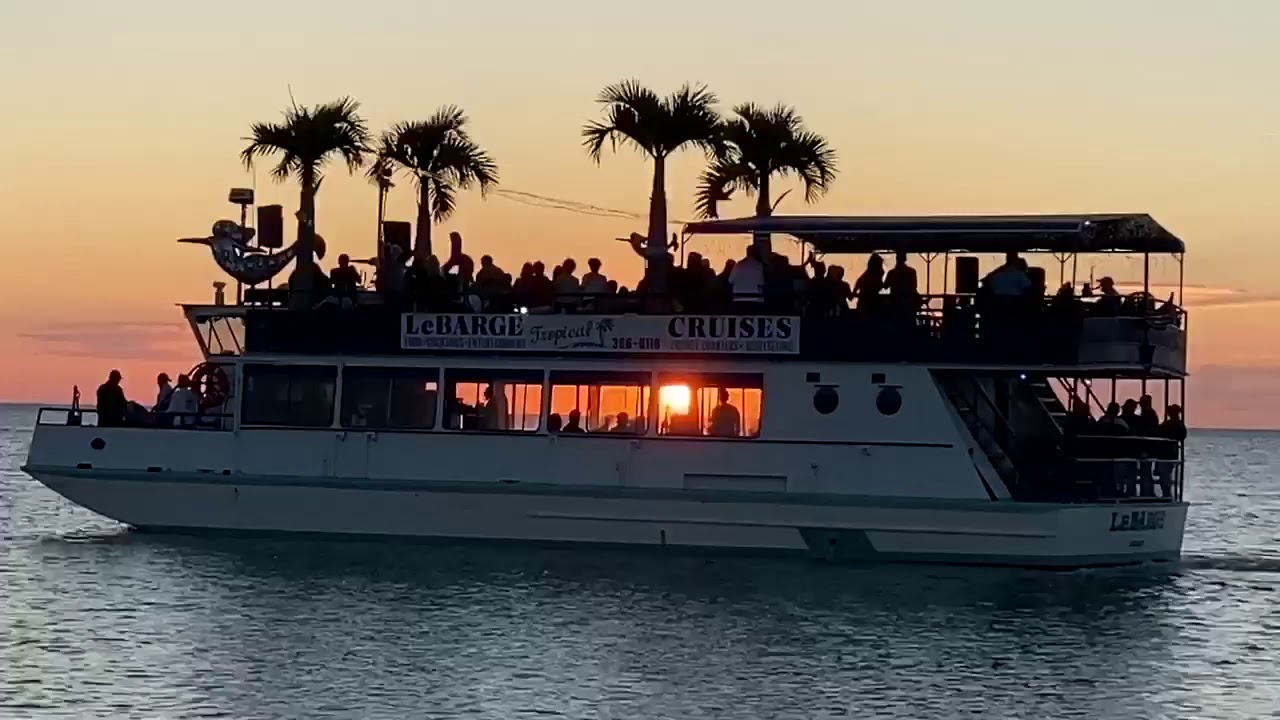
Dinner Cruise Sarasota: A Memorable Evening Experience
- Yachting World
- Digital Edition

Neel 43 on test: Is three the magic number?
- September 17, 2021
Can’t decide between a monohull and a catamaran? The surprising truth is that a fast cruising trimaran, like the Neel 43 could be the ideal solution. Rupert Holmes reports.

Product Overview
Manufacturer:, price as reviewed:.
Until recently it would have been easy to assume the pioneering cruising trimarans of the 1960s and 1970s showed that cruising on three hulls has too many drawbacks to be viable for most, despite the extra space and speed they offered. However, the past decade has seen a resurgence of lightweight fast cruising designs, with spacious accommodation, led by La Rochelle-based yard Neel who recently launched their Neel 43 trimaran.
This latest model, a Marc Lombard-designed 43, is one of those rare boats that defies both expectation and easy classification.
The Neel 43 has the deck space and massive coachroof of the most spacious of cruising catamarans, yet is at least three tonnes lighter than most 42ft cats.

We we tested the Neel 43 in La Rochelle, France with an onshore, 12-16 knot wind with a slight to moderate sea. Photo: by Olivier Blanchet
Another surprise is the low wetted surface area once the windward ama lifts out of the water. Each hull has a narrow waterline beam, so wetted surface area is a fraction of that of a catamaran of similar size. Combined with the light displacement this translates into a boat that’s surprisingly quick.
Neel 43 under sail
After hoisting the mainsail we cut the engine and bore away, unfurling the headsail with the wind on the beam. In only 14 knots of true wind we quickly accelerated to a consistent 10 knots of boat speed.
Sheeting in and squeezing up to a true wind angle of 65° – and 40° apparent wind angle – only saw speed drop by one knot.
Direct Dyneema cables, passing through a minimum of turns, connect the wheel to the single rudder. The helm felt beautifully responsive throughout the test, with a much more direct feel than is generally found on multihulls.

The windward ama lifts easily just out of the water, reducing wetted surface. Stability builds quickly. Photo: by Olivier Blanchet
Tacking proved to be as easy as with a monohull – the boat reliably turned smartly through the wind, with speed rarely dropping much below five knots.
However, visibility from the single raised helm is restricted by the headsail when on starboard tack and by the asymmetric on both tacks.
That there’s a single shallow keel below the centre hull, instead of the two low-profile keels of most catamarans is an important factor in the boat’s handling. It undoubtedly also helps that all the heavy items in the boat, including engine, tankage and batteries, are concentrated low down in the middle of the central hull.
The result is a very comfortable, soft motion that’s easier than that of a typical catamaran, but without the heel of a monohull. In some ways it’s also reminiscent of the easy gait of a heavy displacement long keeler.

The helm felt responsive, with an easy motion. Photo: by Olivier Blanchet
Yet, unlike monohulls, there’s no chance of a broach. Stability builds very quickly after 12-14° of heel is reached, so it takes an enormous force to heel the boat to significantly greater angles. This arguably gives more warning of being overpowered than catamarans, which may generate maximum stability at only 12° of heel.
In addition, the high freeboard means there’s a reassuring amount of reserve buoyancy in the amas, even if the boat is pressed hard in a gust or squall.
On the other hand, a downside of the Neel 43 effectively having a single fin keel is that, unlike most cruising catamarans, it can’t be beached.
Our test boat had standard Dacron sails, so a reasonable set of high-tech sails would undoubtedly see the boat able to squeeze a useful few degrees closer to the breeze without losing too much speed.
Easy motion
However, the reality is that the engine will be used in combination with the mainsail if schedules make a passage to windward essential. Motoring out of the La Rochelle entrance channel head to wind and sea gave a feel for how the easily driven underwater sections behave when motor sailing.
With the single 50hp engine at a comfortable 2,400rpm we made 8 knots, with a gentle motion that didn’t slow the boat.
On turning downwind our speed initially dropped to 6-7 knots at a true wind angle of 150°, until we hoisted the general purpose asymmetric kite. Although it’s not a particularly large sail, this brought the speed back up to 8.5-9 knots, producing our best downwind VMG of 7 knots.

In some ways The Neel 43 sails in a way that is reminiscent of the easy gait of a heavy displacement long keeler. Photo: by Olivier Blanchet
When the breeze picked up a little to 15-16 knots true we sheeted in and luffed up to 115° off the true wind, accelerating to an easy 10.5-11 knots of boat speed. The Neel has so much stability that, even though the sailplan was now generating far more power, there was no perceptible change in heel.
All lines, other than spinnaker sheets, are led to the raised helm station at the front of the starboard side of the cockpit.
Despite its intrinsic speed potential, this is not a boat that’s set up to be constantly tweaked. The deck layout is therefore simple, but efficient. It’s also obviously a cost-effective arrangement, but doesn’t skimp through fitting under-sized winches and other equipment. A powered winch on our test boat took all the effort out of sail handling.
Port and starboard mainsheets – in appropriate colours – give excellent control of the sail shape, without a costly traveller that might endanger the hands of anyone relaxing at the back of the cockpit. The primary sheet is the one on the windward side, while the leeward one gives excellent control of twist.

All lines other than spinnaker sheets are led to the helm station. Photo: by Olivier Blanchet
Headsail sheets are led through a single fixed fairlead. It’s a simple arrangement that minimises coachroof clutter, though twist will increase, spilling wind out of the top of the sail, when it’s partially furled in stronger winds.
Article continues below…

Three hulls, one planet: Neel 51 owner explains how he went self-sustainable
Bluewater sailing stories usually start with someone who has been around boats all their life. But not this one. A…

Three hulls better than two – how the Neel 51 trimaran is challenging its many twin-hulled competitors
Neel has found a clever niche offering the performance benefits of a trimaran with the type of accommodation offered in…
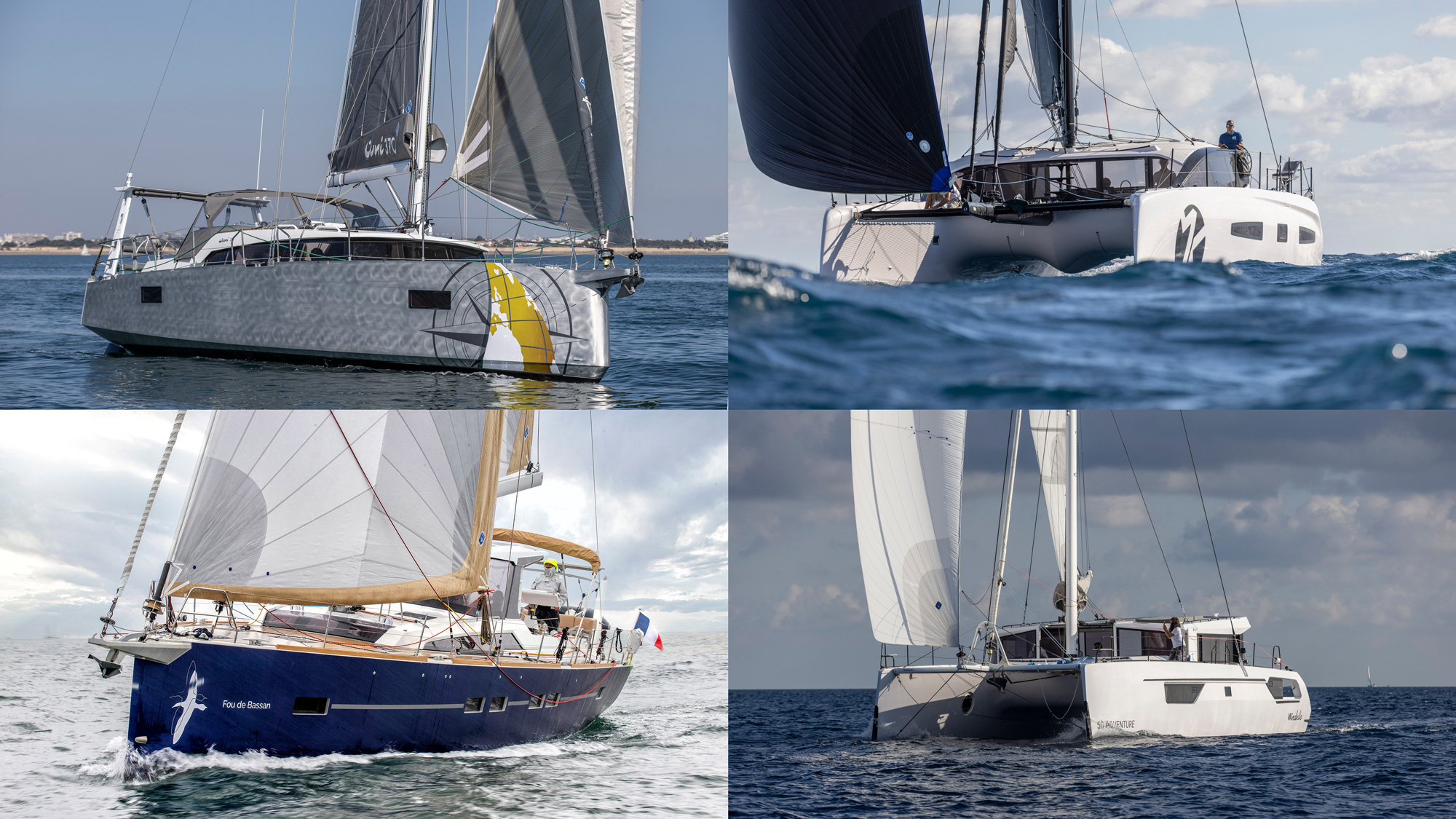
43 of the best bluewater sailboat designs of all time
Which yacht is the best for bluewater boating? This question generates even more debate among sailors than questions about what’s…
The optional free-flying working jib can be hoisted furled, so there’s no inner forestay to get in the way when tacking the genoa when it’s not set up.
If I was specifying the sailplan I’d also opt for a Code 0 for use when reaching with the apparent wind well forward of the beam, plus a large asymmetric shaped for deeper downwind angles than the test boat’s all-purpose sail. This would maximise downwind VMG in light and moderate airs.

Technical heart
An unusual, but appealing, feature of all Neel trimarans is the technical area below the saloon floor in the central hull – on some of the larger models this has an impressive 7ft (2.1m) of headroom, which makes for easy access and fault-finding. However the Neel 43 is smaller, which means this is reduced to generous sitting headroom and floor space is limited.
The central section houses tanks, plumbing and batteries, while the engine and steering gear are further aft. Further forward the space is dominated by a large number of electrical items and connections for solar charge regulators, shorepower battery chargers, inverters and so on.

The saloon opens almost seamlessly onto the cockpit. Photo: by Olivier Blanchet
It’s great that these are easy to access, which also serves as a reminder of the vast number of systems that are often hidden out of sight and distributed around different parts of today’s increasingly complex yachts.
However, there’s a downside that can’t be overlooked. These systems are low down in the boat, close to where any water will collect. Fitting a couple of bilge alarms, and making regular checks when underway by lifting the access hatch in the saloon floor, would therefore be sensible precautions. Despite this drawback it’s still an arrangement that has advantages over many installations.
Loft-style minimalism
What about the interior of the Neel 43? Despite the design’s abilities under sail, in this part of the market it’s the accommodation that sells boats. Yet, once again, this is an aspect that defies comparison with others.

Both transoms have swim platforms. Photo: by Olivier Blanchet
The almost seamless blending of indoor and outdoor areas is appealing, but far from unique among today’s multihull designs.
On the other hand, Neel has gone for the ultimate in a loft-style layout that’s refreshingly different. Masses of windows and large expanses of white fibreglass are balanced by just enough fabric and wood trim to give it some warmth.
Reed-style flooring also adds to a feeling of comfort, in the Neel 43 without increasing weight, and can be taken outside to wash and clean.
There’s excellent near-surround visibility – around 300° – when sitting in the saloon and it’s almost as good when standing.
Forward to port is a watchkeeping station with switch panel, and on our test boat a second MFD, VHF and Fusion audio kit, plus 12V outlets and an analogue steering compass here. However, it stops short of being a full chart table that could also be used as an office, so I’m typing this at the saloon table, which is a great place to work, with brilliant views and lots of natural light.

The saloon and galley area has a very open plan layout. Photo: by Olivier Blanchet
In common with other Neel models, the owner’s cabin is on the same level as the saloon. A downside is therefore a lack of privacy, even with the curtains drawn and door closed. However, it’s a beautifully lit and airy space that would suit those who primarily cruise as a couple.
There’s almost no built-in stowage, although the deep bins in the ama outboard of the bunk will take several large kit bags.
Neat touches for every bunk include a reading lamp with built-in USB port, a folding coat hook for jackets, plus a fabric bulkhead-mounted pouch with space for a phone, tablet, sunglasses, notebook and so on.
These may sound like small points, but it’s surprising how many boats lack provision for these items and they therefore quickly get scattered everywhere.
Natural ventilation is primarily via an opening forward facing window on each side of the coachroof – one for the saloon and one for the owner’s cabin.

A berth is separated by the red curtain. Photo: by Olivier Blanchet
There’s also a small opening hatch in the middle of the coachroof and another for the heads. This is a long, narrow compartment off the starboard side of the saloon.
Overall there’s plenty of space and a shower is included, though it’s not luxurious and there’s no option for a second toilet and shower compartment.
The second cabin is right forward in the central hull, accessed by steps just ahead of the galley. This is a pleasant space with more privacy than the owner’s cabin, though the berth is only 77cm wide at its foot.
A third sleeping area is outboard of the saloon table, aft on the port side of the saloon. This is open plan to the saloon, with curtains for screening, with a generous 140x200cm rectangular bunk with space underneath for kit bags. It would make a great space for kids on passage.

Bright accommodation in the owners cabin with views. Photo: by Olivier Blanchet
For the charter market there’s also an option to drop the saloon table to create an additional double berth, plus small single cabins forward in the amas that are accessed from the foredeck, making a potential maximum of 10 berths.
Few owners are likely to want to sail with that many for long, but the flexibility of being able to cater for extra short term guests, without dragging the weight and volume of spare bedrooms around the rest of the time has an obvious appeal.

Engine is housed in the central hull, with tanks further forward. Photo: by Olivier Blanchet
Given the price of the Neel 43 compared to other multihulls of a similar length it should not be a surprise that it has been conceived to be quick and easy to build, aside from the vacuum infused mouldings that are an important element in keeping weight to a minimum.
Those who love traditional joinery with hand crafted solid hardwood trim will be disappointed and the lack of a second heads will rule the boat out for some.
However, in general the relatively Spartan level of fit out Neel has opted for is appropriate for a boat of this style that’s aimed at a mass audience.
It took Neel 10 years to build its first 100 boats. In the current financial year, ending September, the yard has produced more than 30 boats across a four model range of 43-65ft sailing designs, plus semi-custom fuel efficient power trimarans.
The popularity of the Neel 43 means output is set to grow by a large margin in the coming year.
If you enjoyed this….
Yachting World is the world’s leading magazine for bluewater cruisers and offshore sailors. Every month we have inspirational adventures and practical features to help you realise your sailing dreams. Build your knowledge with a subscription delivered to your door. See our latest offers and save at least 30% off the cover price.
There’s much to like about this design: it’s a cruising boat in every respect, not an outright speed machine, yet it’s one that will quickly leave the competition behind. While it’s not a model that will suit everyone, founder Eric Bruneel has a good understanding of how a vast proportion of owners use their vessels and has created a yacht that will exceed their expectations in many respects. A decade ago trimarans were a niche part of the cruising world, however, the Neel 43 shows the concept of a cruising tri is ready for the mass market. The design has already proved hugely popular and one boat is leaving the factory every fortnight.
- PERFORMANCE TOPICS
Optimising Hull Lines for Performance
This article was inspired by a question about the rocker line in the new 8.5m cat Design 256 and I want to stick to the point, so we won’t turn it into a book, but I’ll discuss two issues, hull fineness ratio and some aspects of the rocker profile.
When you manipulate the hull form you’re adjusting the lines in three planes, waterplanes (plan view), buttocks (side view including the keel rocker) and the section shapes. So you need to be aware of how the shapes are changing in the other two planes as you manipulate any one of these three, or all three globally as is now possible with computer modelling.
There are two fundamental constants that you start with and don’t change throughout the process. The big one is the displacement or the amount of buoyancy you need.
If you make the hull finer by narrowing the waterlines you have to increase the draft or make the ends fuller to get back to the required displacement number.
If you flatten the rocker line you have to increase the hull width, fill out the ends, or square up the section shapes rather than having a V or rounded V.
The other constant is the longitudinal centre of buoyancy. You really can’t do any meaningful shaping of the hull form until you have settled on the these two constants.
A third number that we can plug in as a constant if we want to is the prismatic coefficient which describes bow much volume there is end the ends relative to the cross section shape in the middle of the boat, but in sailing boats this is of less importance compared to other factors.
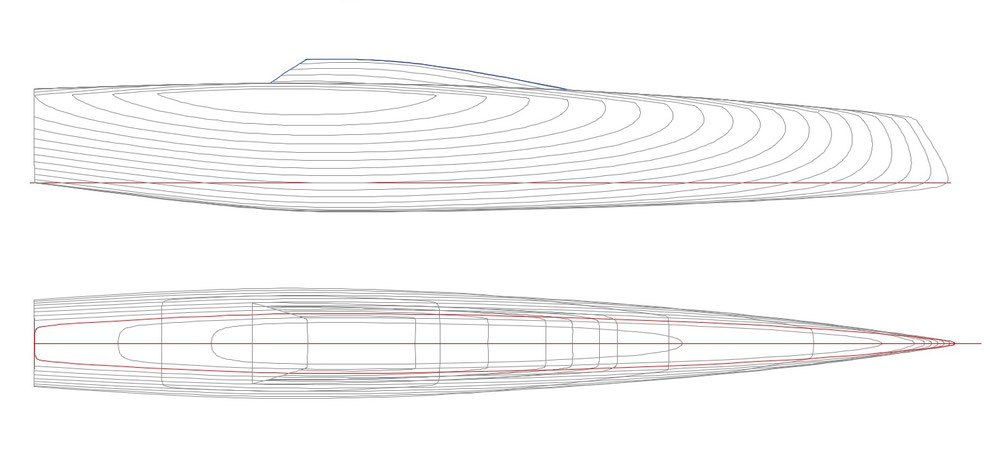
The hull lines for Design 256, 8.5m Cat. It's that hump in the rocker line - right under the back of the cabin that brought up the question and is one of the key points discussed here.
Hull fineness.
Fine hulls are fast, but only in the higher speed range. There’s a misconception I come across quite a bit that you can add weight and windage and you’ll still be fast as long as your hulls are fine.
Well you won’t be. Your boat will simply sink to find the new state of equilibrium. If your transoms are submerged you’ll have more drag. If your bridge deck is too close to the water you’ll have slamming. Much better to be conservative with your displacement figure in the design stage than overly optimistic.
And fine hulls have more wetted area so you have more drag in light air where friction resistance is the primary drag factor.
I’ve seen promotional material for catamarans stating that the boat has less wetted area because it has fine hulls. For a given displacement the minimum wetted area is described by a sphere (or a semi sphere in the case of a floating object). The more you stretch it out in length, keeping the displacement constant, the more wetted area you have.
The more you make the section shape into a deep V or a broad U with tight corners, as opposed to a semicircle, the more wetted area you have. Add into the equation finer hulls are slower to tack.
So fine hulls are only an advantage if your boat is light and has enough sail area to ensure you’re travelling at speeds where form resistance is greater than skin resistance.
In my view the advantage of fine hulls is often overrated as it applies to cruising cats.
At the other end of the scale the resistance curve is fairly flat up to about 1:9 which is still quite fast in most conditions. From there the resistance rises steeply as the hull gets fatter and at 1:8 and fatter you’re suffering from some serious form drag.

This is the rocker line isolated from the lines plan above (in blue) and and the red line shows a more moderate rocker line that achieves the same buoyancy and maintains the centre of buoyancy in the same position. The bow is to the right.
In the image lower right I've squashed it up and increased the height to make the difference in the lines more obvious.
The difference in the two lines is quite subtle, but races are often won or lost by seconds.
Rocker Profile
So if we’re looking for low wetted area we would want a rocker profile that was even and rounded, relatively deep in the middle and rising smoothly to the surface at each end. But this would give us a low prismatic which is not ideal in the higher speed range, and it’s not ideal for pitch damping which in my view is the critical design factor that is often underrated.
Pitching is slow. It destroys the airflow in your sails and the flow around the hulls, and your performance is suffering from slamming loads.
The single most effective way to counter pitching is with asymmetry in the water planes. You can achieve that in the with a fine bow and broad transom. Or you can achieve it with V sections forward and a flattened U shape aft. Or you can achieve it in the profile view with a very straight run forward and a bump in the aft sections. A flatter rocker line is better for resisting pitching than an evenly curved one with deeper draft in the middle.
The final result is a combination of all three of these factors.
On a cat like Design 256 the weight is concentrated well aft so we need to get buoyancy well aft.
The kink you see in the rocker profile helps to do this. It also helps to keep the rocker straight for most of its length and smooth the water flow exiting the hull aft at higher speeds, possibly promoting some planing effect.
If we had a more even rocker line we would slightly reduce the wetted area, but we would increase the pitching and the water would exit the hull aft at a steeper angle, increasing form drag in the higher speed range.
How much of a bump can you put in there without creating a flow separation, and how damaging would that flow separation be? I really don’t know. The way all of these factors interplay in the various conditions we sail in is very complex.
Ultimately a lot of this work is gut feel nurtured by experience, observing things in nature and most importantly experimenting and trying new ideas.
Is the new Groupama AC45 a breakthrough that will influence the form of racing catamarans into the future? I don’t think anyone has a computer that can answer that. We have to wait and see.

Symmetric and non symmetric water-planes. The blue line with grey fill is the DWL from the design above. As is typical with modern cat hulls the bow is long and fine, the stern is full and rounded. This is the asymmetry that has a damping effect on pitching. The red line on the other hand is more like you would see on a double ended monohull and quite a few multihulls have also used this shape in the past. It's quite symmetric about the pitch axis and does not have good pitch resistance.
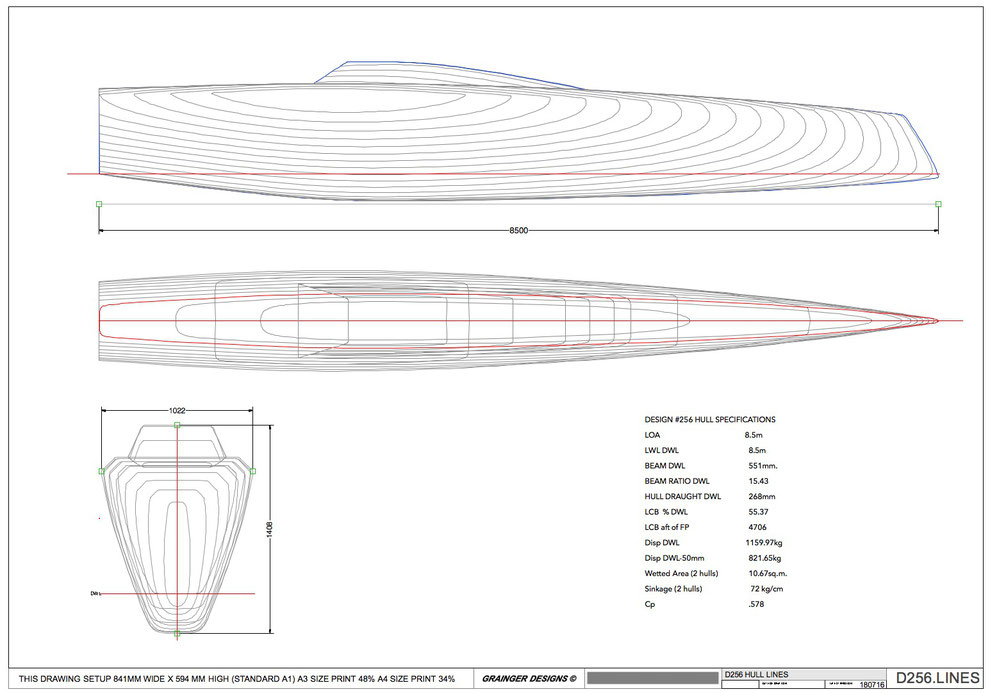
The hull lines of the new 8.5m Sports Cat Design 256
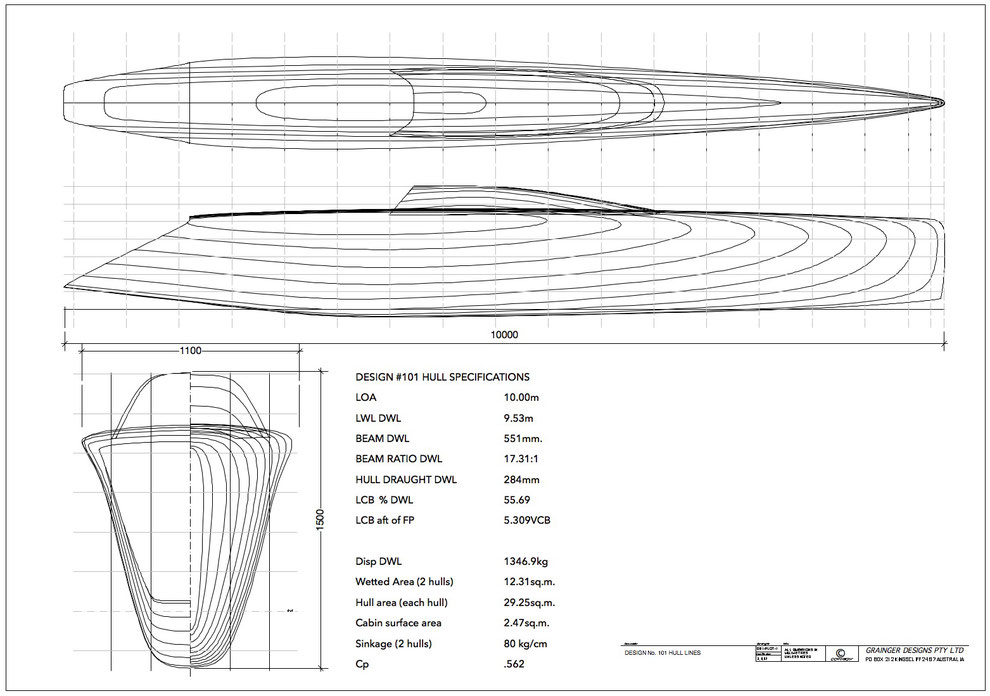
Mad Max , Previously Carbon Copy . She was designed in 1997 but she's the current (2016) title holder of the Australian Multihull Chamionships (2 successive years) and the fastest inshore racing boat in Australian waters.
- Scroll to top

16 Best Trimarans For Sailing Around The World (And a Few For Daysailing)
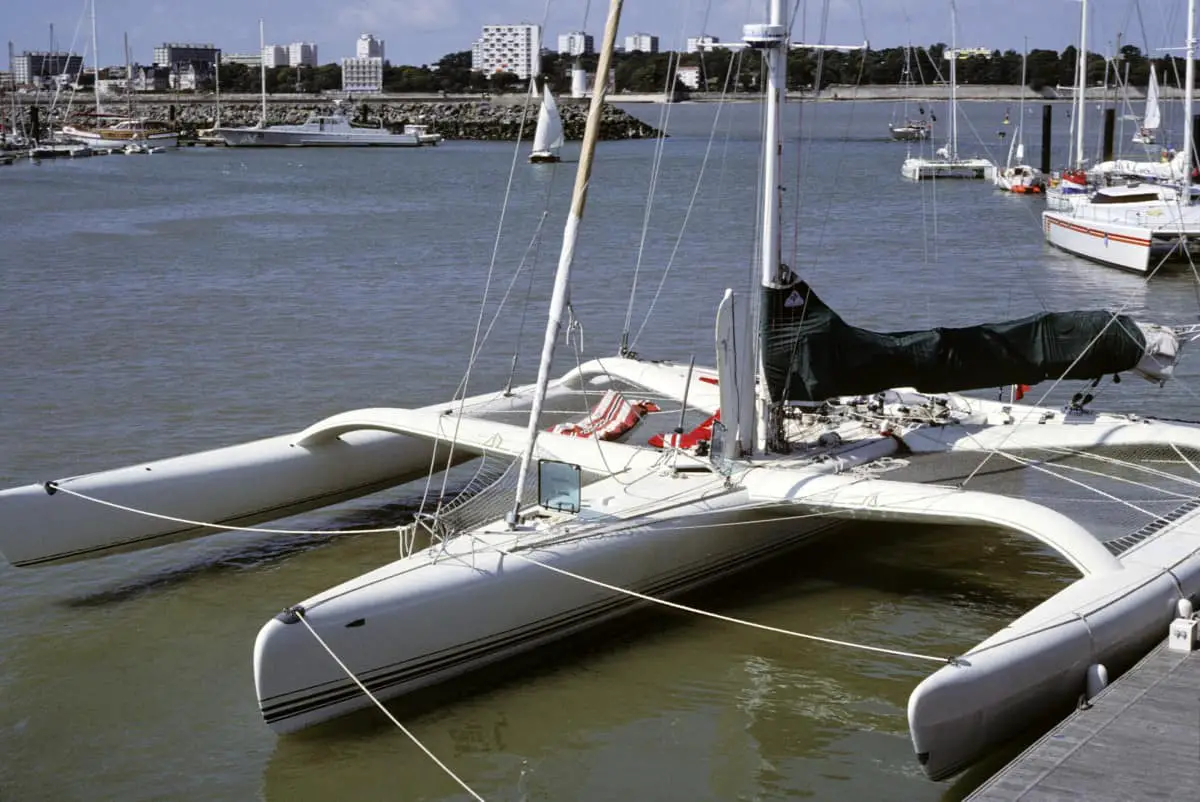
As an Amazon Associate, we earn from qualifying purchases. We may also earn commissions if you purchase products from other retailers after clicking on a link from our site.
Trimarans are growing in popularity worldwide, due to their light construction and high stability these multihulls are even faster than catamarans. Trimarans are still one of the lesser-known boat types so in this article ill be checking out some of the most popular models.
The best trimarans include:
- The Neel 43
- The Neel 47
- Dragonfly 28
- The Pulse 600
- Corsair 37
These tris are built with your safety in mind while also packing powerful speed and a wide array of comfort features to optimize your sailing experience , some are even foldable making them possible to load on a trailer and transport to the sailing destination of your choosing.
In this article, I have created a list of the 16 best trimarans in the market and their unique features. You’ll also learn the best options for different purposes such as circumnavigation, weekend sailing, racing, and more.
Table of Contents
What Is a Trimaran?

A trimaran is a multi hulled sailboat with three individual hulls; the main hull ( vaka ) and a pair of outrigger hulls ( amas ). These smaller outrigger hulls are attached to the main hull using beams.
While trimarans have a rich history dating back nearly four millennia, these types of sailboats have only gained popularity in the late 1900s and early 2000s.
Trimarans are primarily used as personal boats for sailing enthusiasts or racing. These sailboats draw their versatility from their lightweight design, making them faster and easier to handle at sea when compared to single-hulled boats (monohulls). Additionally, the three hulls also contribute to better stability, making it very hard to capsize (although more likely than a cat according to this study)
Trimarans come in various sizes, and some can be as small as 19 feet (5.8 meters) in length, while others go up to 60 feet (18meters). They’re also used for different purposes. Most trimarans are used for racing and recreational purposes, although some units are still used as ferries.
As with all things, to find out which is the best we need to understand what it will be used for. There is a big difference in requirements between a boat used for day sailing compared to offshore around the world sailing.
The list below highlights the best trimarans for different purposes.
Best Trimarans For Cruising, Liveaboard and Sailing Around The World
The Neel 43 is a French trimaran best suited for cruising. Its key features include:
- Easy maneuverability on the open sea by only a small number of crew members
This unit is also built for comfort, ideal for more extended travels. This 43-feet (13-meter) trimaran is also made with recyclable and bio-sourced materials, highlighting the manufacturer’s commitment to environmental consciousness.
This trimaran has a base price of €329,000 excluding VAT. This translates to approximately $370,138.
2.Neel 47 Possibly The Best
Named the best full-size multihull for 2020, the Neel 47 is a strong contender for one of the best trimarans in the market. This 47-foot (14.3-meter) long trimaran features optimized exterior and interior ergonomics for a unique design and look.
Still on design, the Neel 47 is ideal for couples looking to take a weekend off or spend some time as liveaboard. It has a spacious owner’s cabin and two bedrooms. It also features a spacious living room and kitchen and is optimized to ensure comfort for a couple.
The Neel 47 also has two basic guest cabins so your friends or children can tag along on your sailing adventure. Accordingly, this unit is ideal for those looking to explore the sea for the sheer joy of sailing.
The Neel 47 comes at a 571,139 euro ( $643,600 ) price tag, excluding VAT.
3. Rapido 60 The Fast and Comfortable Circumnavigator
The Rapido 60 offers a blend of performance, safety, and luxury, making it one of the best options for bluewater sailing. Measuring 59.3 feet (18 meters) in length, the Rapido 60 is an imposing unit. It’s made from lightweight sandwiches and carbon materials that provide speed and strength, allowing it to stand up to strong ocean currents.
The Rapido 60 also has spacious living spaces and is built for comfort at all points of the sail. Its design also optimizes safety. While it’s an ideal option for circumnavigating, it’s also an excellent choice for racing due to its speed.
This is also the same boat that The Youtube channel La Vagabond just purchased.
The Rapido 60 retails at $1,400,000 .
4. Rapido 40
The Rapido 40 measures 39.4 feet (12 meters) in length and is ideal for cruising around the world. The Rapido 40 features twin “C” foils, which provide added lift, enhancing its speed and performance whether you are sailing downwind or upwind.
Because it has C foils, this trimaran doesn’t have a central daggerboard, increasing interior space. Accordingly, it’s an excellent option for couples looking to cruise and enjoy great performances .
The Rapido 40 is made from high-tech all-carbon materials for a lightweight yet sturdy design. This material is also used for the countertops and furniture, and the cork flooring adds a touch of style.
This trimaran retails for $595,000 , making it a cheaper option than the Rapido 60.
5. Dragonfly 40
The Dragonfly 40 measures 40 feet (12 meters) in length. It features high-comfort standards, making it one of the best trimarans in the market for taking your family for a cruise. Because of its larger size, it has a better capacity, being capable of accommodating six to eight people, so you can bring your family and friends along.
It’s easy to navigate and extremely safe. With a maximum speed of 24 knots (44.5 km/h), this trimaran also provides fast speeds to make your cruise even more exhilarating.
The Dragonfly 40 retails from €509,000 exclusive of VAT, which rounds up to $572,000 .
6. Dragonfly 32
The Dragonfly 32 is a high-performance cruiser. Like the Dragonfly 28, this unit features a contemporary design for racing. This trimaran can accommodate five to seven crew members.
Although slightly longer than the Dragonfly 28 with its 32-foot (9.8-meter) length, the Dragonfly 32 has a max speed of 23+ knots (42.6+ km/h), making it one of the fastest trimarans for racing. This unit also has comfortable accommodation, which makes it an ideal option for a weekend cruise with family and friends.
The Dragonfly 32 has a base price of $350,000 .
7. Corsair 37
Thanks to a variable draft with a retractable rudder, the Corsair 37 is an ideal choice for shallow water exploration. This 37-foot (11.3-meter) long trimaran features advanced foam-cored construction designed for safety, making it virtually unsinkable.
The carbon hulls minimize weight, this makes for a lightweight ocean exploration sailboat with blistering speeds. One of its selling points is that this trimaran has previously been used for Arctic expeditions, possibly marking it as one of the better options for circumnavigation and offshore sailing in the northern waters.
This trimaran has a base price of $189,000 but can go up to $204,125 .
Best Trimarans For Day/Weekend Sailing
8. dragonfly 28.
The Dragonfly 28 is a 28-feet (8.75-meter) long sailboat that can accommodate up to five people. It comes in two versions:
- Touring version: This version is ideal for families.
- Performance version: This is built to provide optimal performance for the sports enthusiast within you.
It clocks a maximum speed of 22+ knots (22+ km/h) and is beam-folded. It’s an excellent option if you want a high-performance, comfortable yet smaller unit for your day or weekend cruise.
The Dragonfly 28 starts at €188,280 inclusive of VAT, which comes to around $211,600.
9. Dragonfly 25
Like other trimarans under the Dragonfly brand, this 25-foot (7.62-meter) trimaran is great for both racing and short term cruising. However, this high-performance boat delivers easy handling, making it perfect for couples looking to take a ride out over the weekend and seasoned sailors looking for an exhilarating racing adventure.
The Touring version features a lightweight build and offers comfort and accommodation to keep you, and the few guests you can fit, comfortable during the ride. This trimaran also has a Sport version, which is optimized for racing.
The Dragonfly 25 retails from EUR 86,800 .
10. Pulse 600
The Pulse 600 trimaran is a compact sailboat. It’s made from lightweight, carbon-reinforced construction and vacuum-formed materials for optimal speed. This trimaran is an ideal option if you are looking for speed.
It also features ample deck space, greater stability, and volume than most trimarans of similar size and build.
This trimaran measures 19.8 feet (6 meters) in length and can be sailed single-handedly by one person with minimal effort. The Pulse 600 has a base price of $38,800 , which places it in the lower price range.
The F-22 is one of the smaller trimarans in the market. Developed in New Zealand, the F-22 is a folding trimaran built for speed. The hulls are made from narrow fiberglass tied together using fiberglass beams and aluminum, minimizing bulk while optimizing speed.
The F-22 is roomy and is not as pricey as other models in the market. This trimaran has two main versions:
12. 2019 Weta Trimaran
The 2019 Weta trimaran is a 14.5-foot (4.4-meter) trimaran featuring a carbon frame, centerboard, rudder foil, and rudder shock. The hull is made from fiberglass and foam. The Weta is built for strength and speed based on these lightweight materials.
The 2019 Weta trimaran is easy to sail and is worth considering whether you want to take a quiet sail, race with your friends, or take kids to a sailing lesson. It has a simple design and is easy to set up independently. Thanks to its collapsible design, this trimaran is easily stored away with minimal space demands.
13. WindRider 17
The 17.4-foot (5.3-meter) WindRider 17 is one of the more versatile trimarans in the market. It packs high performance for a low cost. This trimaran has a light rotating mast to boost performance, and a full-battened mainsail optimizes visibility.
This sailboat is made from rotomolded polyethylene, which is more durable than fiberglass and demands less maintenance.
The WindRider 17 has a comfortable interior and can fit six adults. This is an ideal choice for social sailing for a couple or a family and friends. It’s easy to ride, and a shallow draft allows easy maneuverability.
14. Astus 22.5
If you’re looking for something small but still comfortable, this 22.5-foot trimaran is for you. Built for speed and maneuverability, the Astus 22.5 has optional foils to optimize speed. The modern design, coupled with the spacious interior, can fit up to four beds. Accordingly, this trimaran is suited for family outings.
This trimaran also has a foldable design, collapsing to only 16 feet (4.9 meters) for easy storage.
15. Multi 23 Trimaran
The Multi 23 trimaran has a contemporary design, featuring a vinyl ester and PVC foam core construction. The section below the waterline is made of solid glass for a sturdy base.
The beams are made of lightweight carbon, and the trimaran features a 33-foot (10-meter) aluminum rotating wing mast for optimal harnessing of the wind. While ideal for weekend excursions with family, once rigged with the asymmetrical spinnaker will get your heart pumping.
This trimaran packs high performance at a lower cost than most other options in the market. It’s a good choice if you are looking for a high-performing unit without spending an arm and a leg.
16. Challenger Class Trimaran
The Challenger Trimaran 15 is the best choice for persons with disabilities. It’s designed to provide disabled sailors an opportunity to explore their passion for sailing without worrying about aspects like safety or operation.
A man named Geoff Hold circumnavigated the British Isles in 2007, becoming the first disabled person to achieve this feat. He had quadriplegia.
Living up to its name, the Challenger can withstand harsh weather conditions while blending performance with speed.
Final Thoughts
Admittedly, no trimaran is best for everyone. But whether you are looking to race with your friends, take your loved ones or friends for a cruise over the weekend, or circumnavigate the ocean, you can rest assured that these lightweight trimarans will deliver speed, safety, and comfort to make it worth your while.
These brands are innovatively designed and feature intricate safety mechanisms that make them virtually unsinkable. Give them a shot and begin your ocean adventure.
- Basco Boating: A Comprehensive Guide & Introduction to Trimaran Yachts
- TheBoatAPP: New Trumarans: Which are the Best Ones
- Corsair Marine: Corsair 37
- Dragonfly: Dragonfly 28
- Rapido Trimarans: Rapido 60
- Neel Trimarans: Neel 43
- Yachting World: World’s Collect Yachts: Maxi Trimaran MACIF
- Yachting Monthly: Dragonfly 28 Performance
- Rapido Trimarans: Rapido 40
- Dragonfly: Dragon 32
- Dragonfly: Dragonfly 40
- Yachting World: Dragonfly 40 yacht tour: This cruising trimaran can do 24 knots
- Dragonfly: Dragonfly 25
- NauticExpo: Dragonfly 25
- Yachtworld: Corsair 37 boats for sale
- Cruising World: Neel 47 Trimaran: Best Full-Size Multihull0
- Neel Trimaran: Neel 47
- Multihull Solutions: NEEL 47 Boat Review | Cruising World
- Yacht World: 2022 Neel 47 for sale
- Farrier International: F-22
- Weta Marine: The Boat
- WindRider: WindRider 17 Trimaran Sailboat
- Astus Boats: Astus 22.5
- Boat-specs: Multi 23
- National Maritime Museum Cornwall: Challenger Trimaran #1 – BC26
Owner of CatamaranFreedom.com. A minimalist that has lived in a caravan in Sweden, 35ft Monohull in the Bahamas, and right now in his self-built Van. He just started the next adventure, to circumnavigate the world on a Catamaran!
Leave a Reply Cancel reply
Your email address will not be published. Required fields are marked *
Save my name and email in this browser for the next time I comment.
Recent Posts
Must-Have Boat Gear for Catamaran Sailors!
Sailing is probably the most gear-intensive activity I've ever done; there are so many decisions to be made about what gear to buy now, for tomorrow, and what to definitely never buy. The gear on...
6 Best Trailerable Trimarans For Bluewater and Coastal Sailing
Having a boat costs a lot of money, even when you are not using it, marina fees, etc. And once it is in the water most sailors never go very far from their "home marina" and sailing will be somewhat...
- Apply for Vendor
- Vendors List
- Delivery & Payments

Trimaran Neel 43 Review
This review is dedicated to the unique three-hull yacht Neel 43 trimaran , which has collected all possible prizes in its category since its release in 2021 by the Neel Trimarans shipyard. Here's what impressed the selection committees when determining the winner, and what attracts sailing enthusiasts and businessmen to Neel 43.
Traditionally, in addition to the review from the topRik team, we present the opinion of the leading yachting media, whose journalists participated in testing this unique catamaran. What makes it unique? Find out in our review!
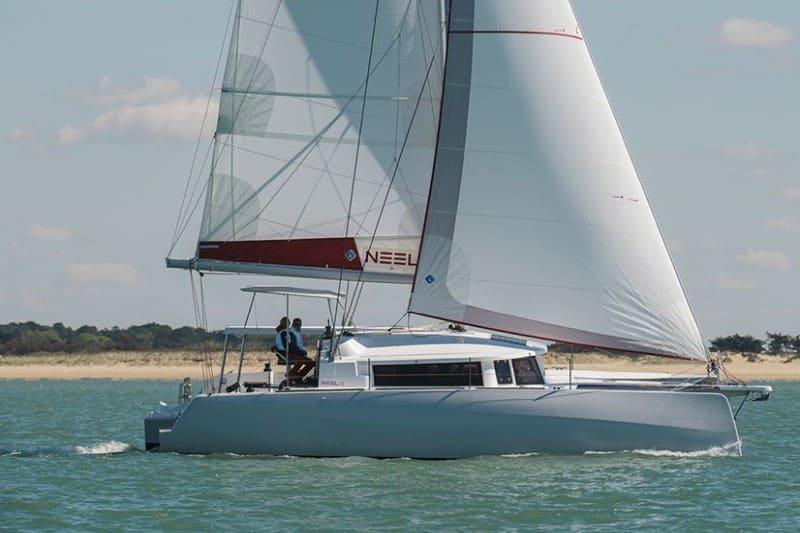
To avoid tormenting the most impatient, we will hint at the main signs by which you can recognize a sought-after Neel 43 at a glance.
This is a loft-style deck - here, on one level, you can find all the main areas where the owner of the trimaran and his guests stay.
This common space without any frills is subject to the main thing: the optimal ratio between the performance of the boat, the ease of management, on the one hand, and the sufficient comfort of life on board, on the other.
TopRik team, before offering the Neel 43 trimaran to you, intends to check all the claims of the shipyard about its advantages on board this three-hull yacht. Follow us on this endeavor!
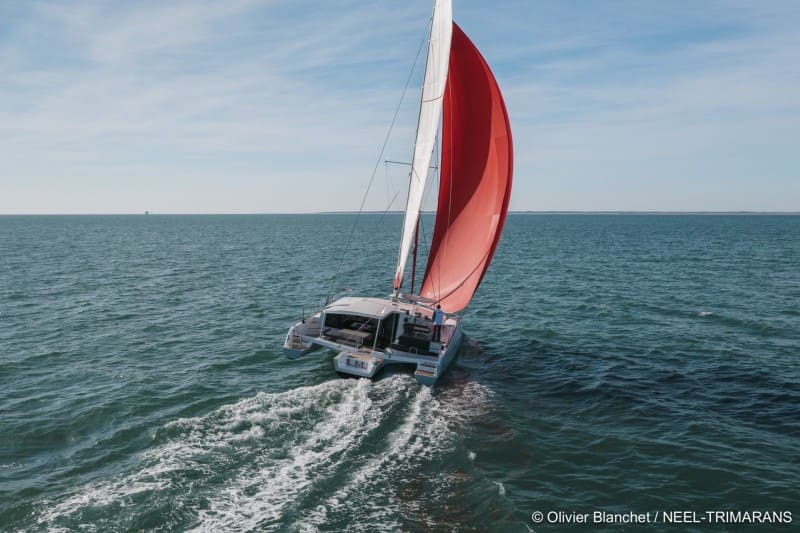
Features of Neel 43 Trimaran
- Brand: Neel Trimarans
- Hull type: Trimaran
- Overall length, m: 13.1
- Width, m: 7.5
- Displacement, t: 9
- Air draft, m: 19
- Water tanks, l: 500
- Exterior design (Architect): Marc Lombard/Yacht Design Group
- CE Certification: ICNN
- Mainsail type: Fully battened
- Jib type: Furling genoa
- Mainsail area, m²: 58
- Jib area, m²: 43.2
- Engine: diesel sail drive 50 hp
- Fuel tanks l: 300
Max speed Neel 43
The maximum speed of the Neel 43 trimaran depends on various factors such as wind conditions, sea state, sail configuration, and the weight of the vessel, crew, and equipment. However, the manufacturer states that the Neel 43 has a maximum speed of around 20 knots (23 mph or 37 km/h) under ideal conditions.
It's worth noting that cruising trimarans like the Neel 43 are typically designed for comfort and stability rather than speed, so their top speeds are usually lower than those of racing trimarans.
Review Neel 43 by topRik Team
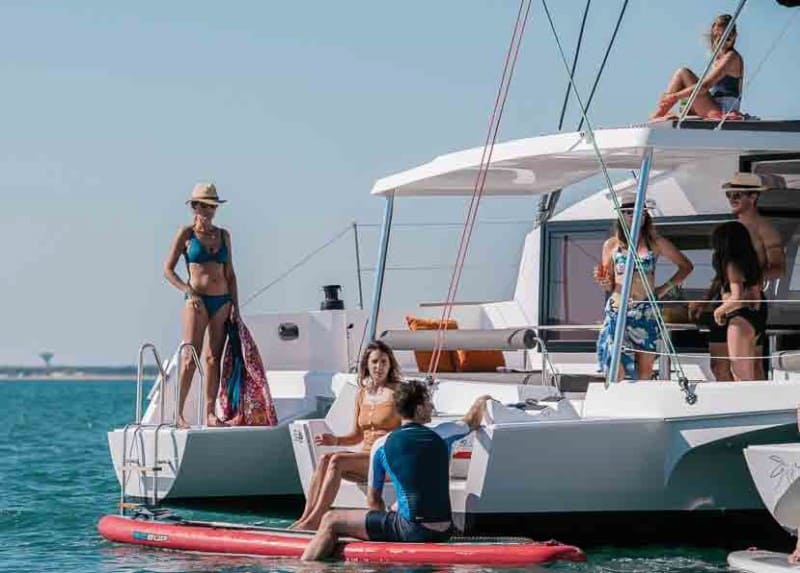
No, no, the photo above is not the topRik team, we do not look so romantic, we do not wear bikinis, and we do not mix yacht testing with cocktails. We just have a good imagination - and we immediately imagined how this transom might look in a "busy" state. Note that a good third of the transom on the starboard side is not even included in this photo. Let's take a closer look at one of the ladders - this is the one where the girl in the blue bathing suit stands, on the port side.
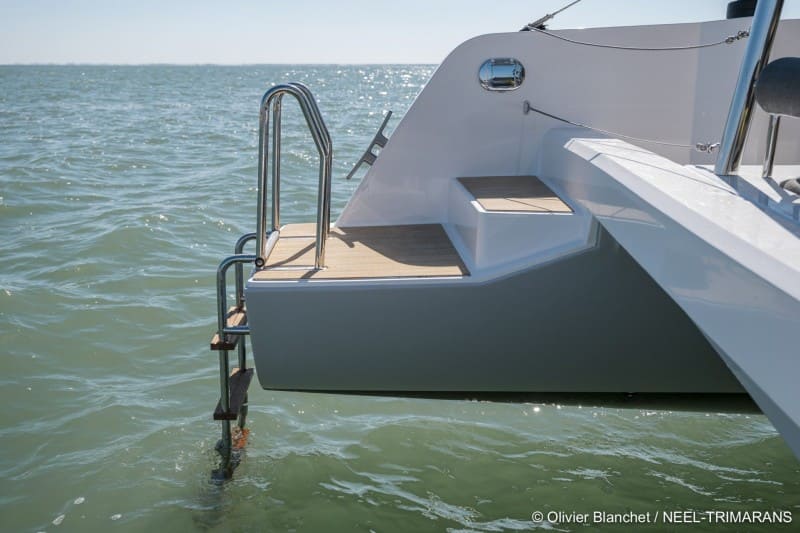
You can see that this is not just a ladder , but at the same time a rather extensive swim platform - this is hinted at by the onboard ladder and common sense. Exactly the same platform, or gangway, is located on the starboard side.
And between these two ladders there is a huge main platform, which can serve as a boathouse for a PVC motorboat, jet ski, folding bikes, kiteboards, windsurfers and other useful things. Especially when you consider that under it you can find a very roomy locker for a life raft.
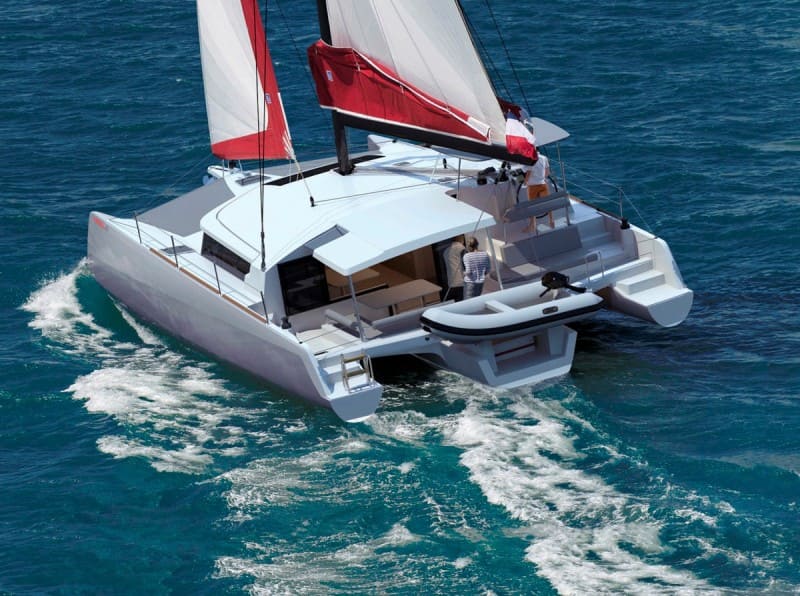
A Bit of Theory at a Glance
From the pier, we have a view of the massive roof over the cockpit, low lowered boom, slightly sloping mast and bimini over the helm station. The ribbed contours of the hulls attract attention - this will limit the rocking of the trimaran. A very wide vaka with a normal amas width may indicate that a large amount of equipment is placed in the central body to balance the weight distribution for high performance.
Although, as far as we know, the weight of this trimaran is even less than most catamarans of the same size. This was achieved through the use of technologies that have already proven themselves to be reliable in hull manufacturing process, as well as through innovative technologies used in making non-structural elements. In the first case, sandwiches made of foam and glass reinforced with a polymer fabric are used, in the second, a cork core is used.
The reduction in weight also reduces the wetted surface area, which makes it easier to control the trimaran when maneuvering and tacking under sail.
While there are enough theories, it's time to climb the ladder to the cockpit. While our skipper moved straight from the transom steps to the steps leading to the helm station, the rest of the topRik team decided to test the capacity of the cockpit and, of course, the capabilities of the aft galley.
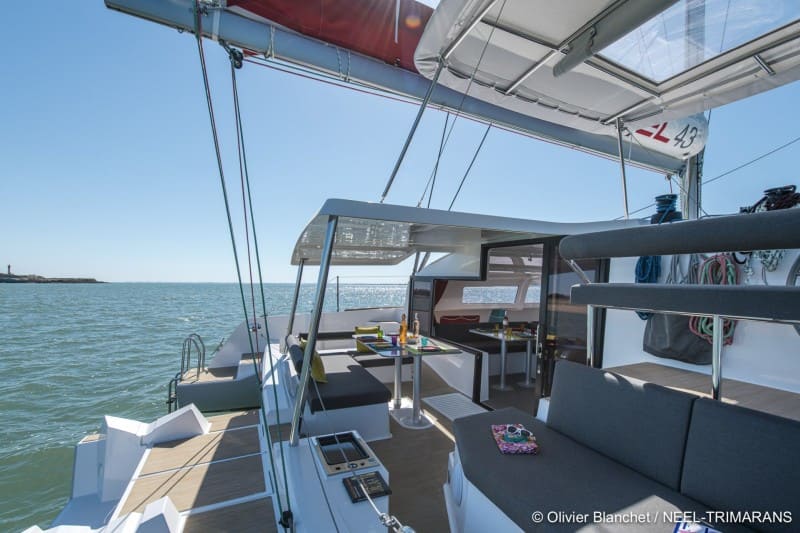
Loft Is Such a Loft
Let's not forget that the Neel 43 is billed as a 10-passenger boat, which is important not only to those future owners who plan to bring as many friends on the cruise as possible or take the whole extended family on the trip. The maximum capacity of the yachts is also important for entrepreneurs who rent them out.
So, we inform all interested parties: the yacht will freely accommodate 10 passengers, even without the skipper and crew - this ten will have enough space even in the cockpit.
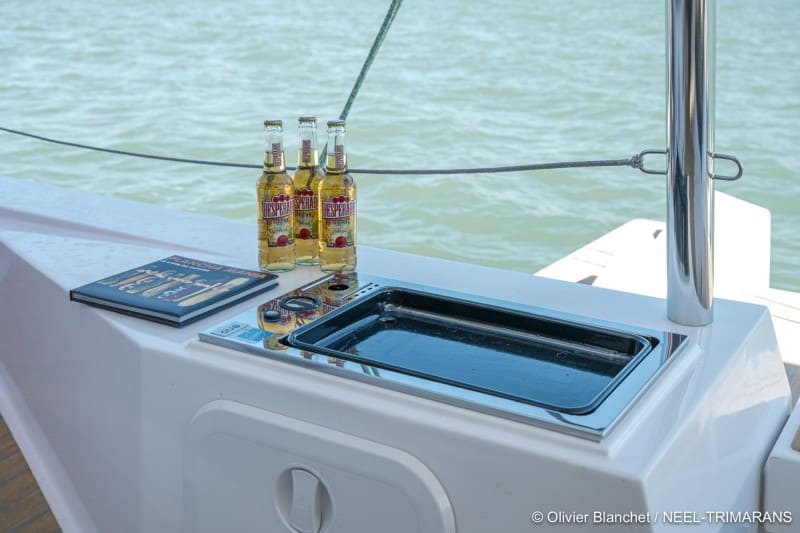
And if suddenly someone does not have enough space, you can always move to the saloon. Moreover, the shipyard has remained true to itself and has retained this deck in the loft style, where the cockpit almost imperceptibly merges with the saloon. Yes, this is the famous “cockloon”, where the cockpit and saloon are separated or, more correctly, united by large sliding doors.
We have already shown the view from the cockpit to the saloon: both tables are practically adjacent, passengers can freely communicate through a large open window. Through it, you can also transfer dishes cooked in the galley.
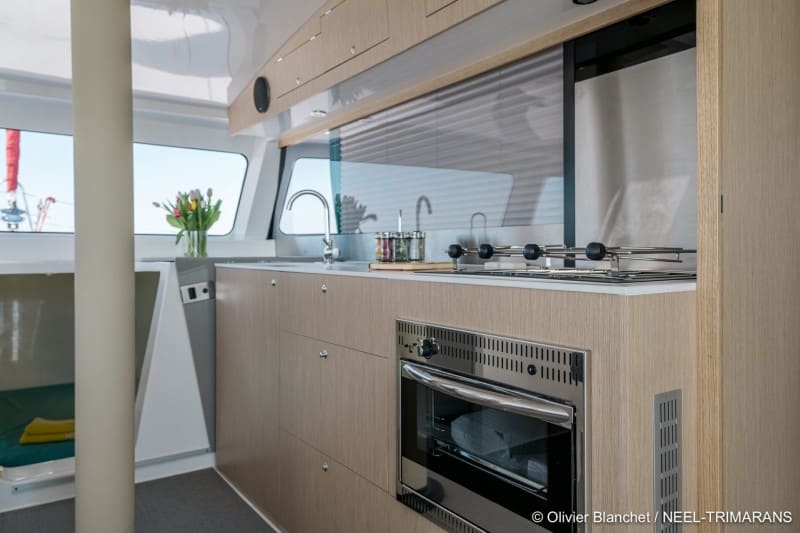
And in the photo below there’s a good view from the saloon to the cockpit - you can appreciate the galley and its linear arrangement. More than one cook can handle it at the same time, since the approaches and aisles are very open. You see plenty of seating around the table and on the double sofa. What is behind the curtain? Bed? Exactly! It’s the loft.
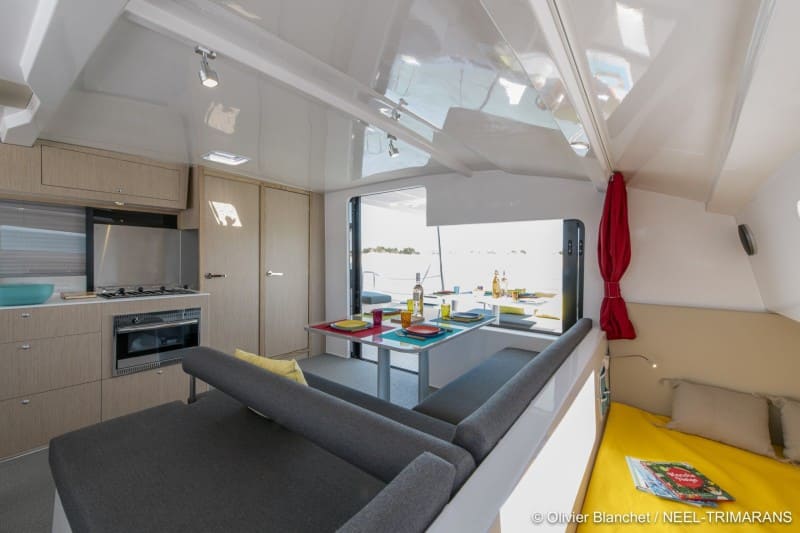
But wait to be surprised and perplexed. Everything is very logical if you see the rest of the cabin. There is a full-fledged charting table - the second control post after the one our skipper has already taken at the helm. And when he is replaced after the night watch, he can immediately go to rest on this comfortable large bed, taking some time out from the navigation table, marine tools and chartplotter .
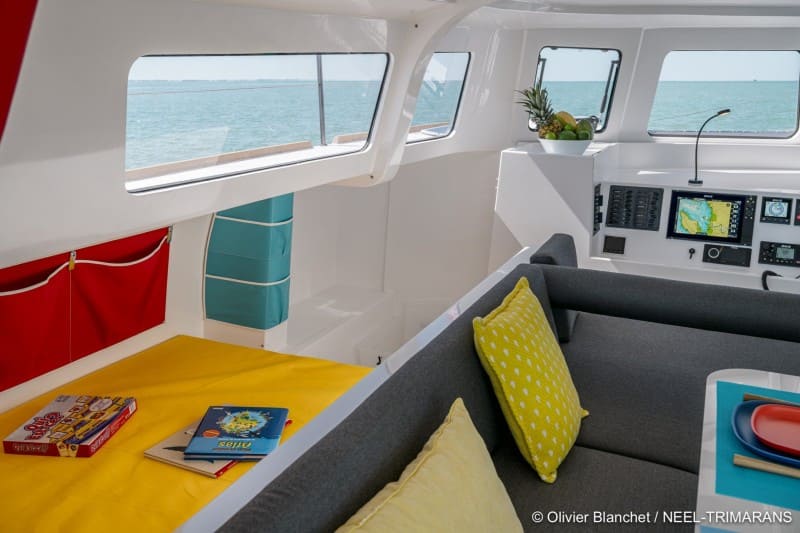
And if you are traveling with your family, this is a great place for children to sleep or play – it can always be under the supervision of adults, both day and night.
Some may be surprised by the amount of storage space for food and kitchen utensils, but we were struck by the spaciousness, which seems simply immense due to the large area of glazing. Panoramic views and natural light add to this feeling of freedom on board Neel 43.
The height of the rooms on the test yachts, as usual, was tested by our expert, whose height reaches 2 meters. In the cockpit and saloon, he didn’t even need to bow his head - he walked, proudly straightening up all the way, and there was still a lot of free space above his head.
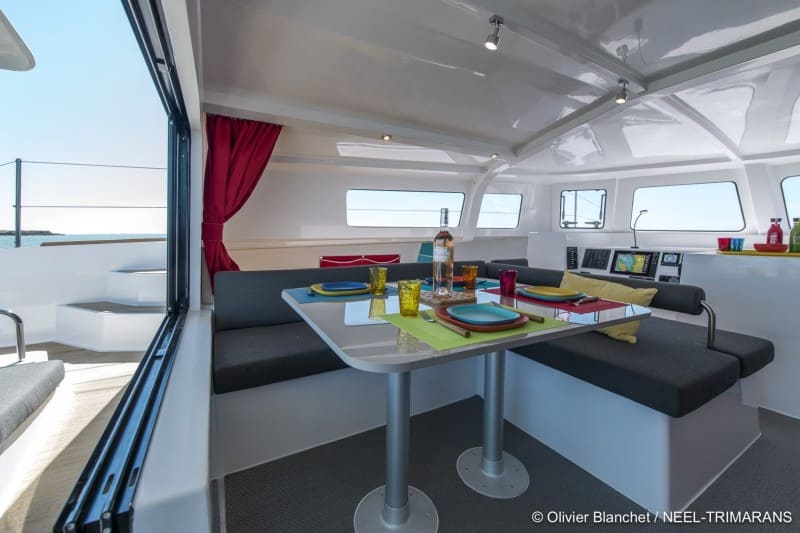
Always on Duty
– What are you doing here?
In our fascination with the “cockloon” and the possibilities of the grill and galley, we somehow forgot about our skipper, who stayed to study the helm station.
– Testing, - the team mumbled indistinctly with their mouths full. - We decided to share the responsibilities: since you are on duty, we’ll cover this area just fine...
After everyone paid tribute to dinner, they went to inspect... no, not the cabins, but the control station in the cockpit. We studied the charting table quite well - nothing unexpected: a large chart plotter, communication equipment, radio, electrical panel, tool indicators that control all the equipment of the trimaran.
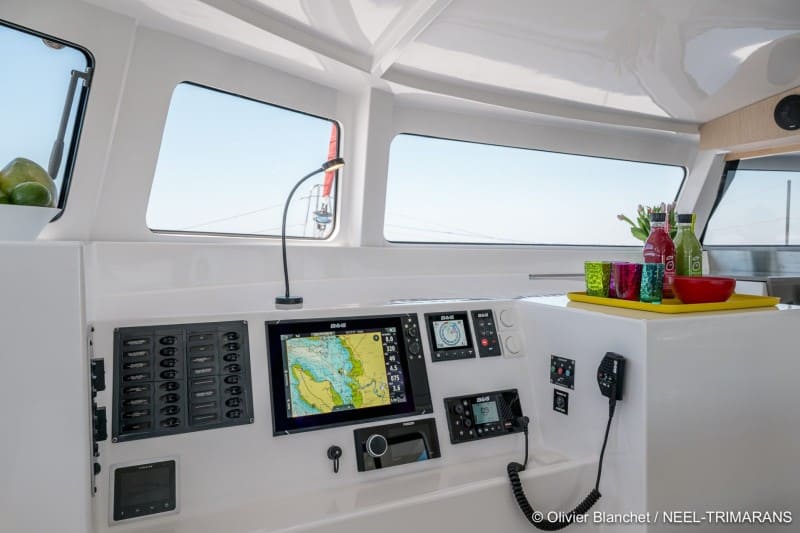
Located on a raised platform on the starboard side, the helm station has an entrance from the transom side and from the cockpit side. In front of the helm there is a skipper's chair, where an assistant will comfortably fit.
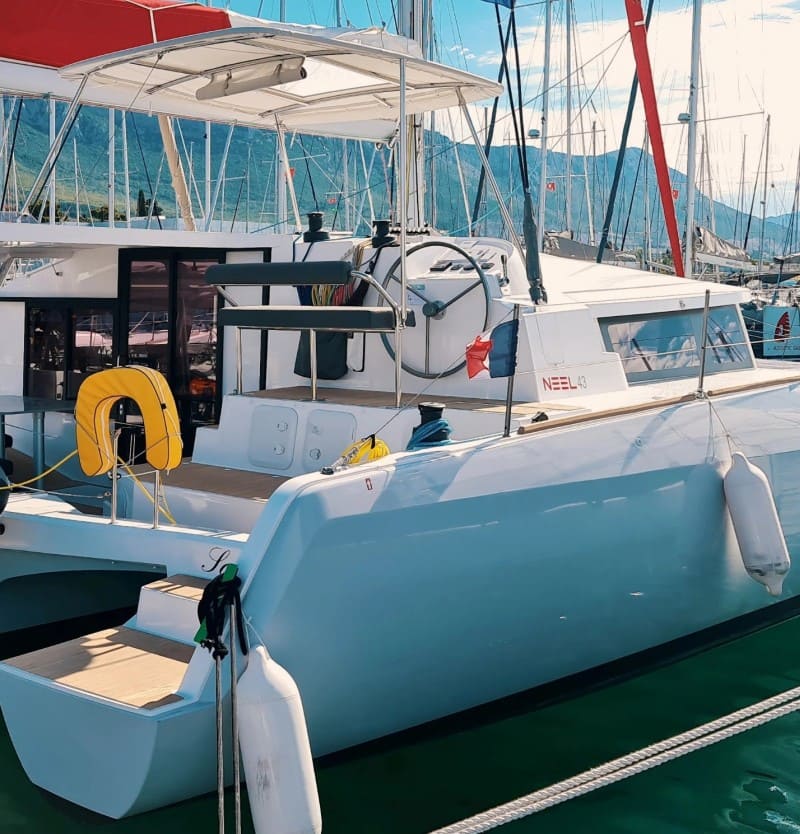
All lines, except for spinnaker sheets, are brought to the winches located at arm's length or within walking distance. The staysail sheets pass through one fixed hawse. Our trimaran had an electric winch, which makes it much easier to work with the rigging.
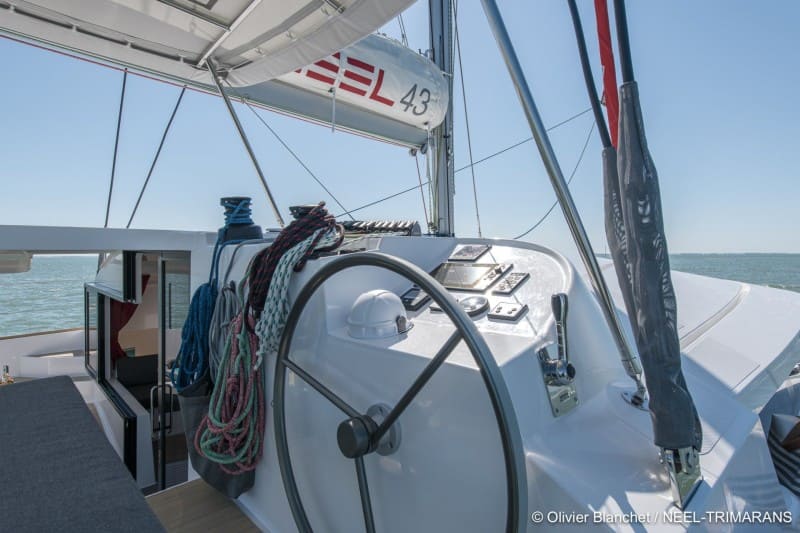
The control panel is practically a double of the saloon control panel in terms of the set of instruments. To the right you get your throttle.
From the helmsman's seat there was an excellent view of all three bows of Neel 43’s hulls until the sails were raised. There are some problems here depending on the rig used. Later we found out that the front view is still blocked when the headsail is raised on the starboard tack or an asymmetric spinnaker is raised on both tacks.
In the Engine Compartment
Spacious and with a high ceiling - everyone liked this compartment, even the aforementioned crewman, who still had more than 10 centimeters of space left above his head. The compartment is located in the central float, the entrance to it opens from the cabin.
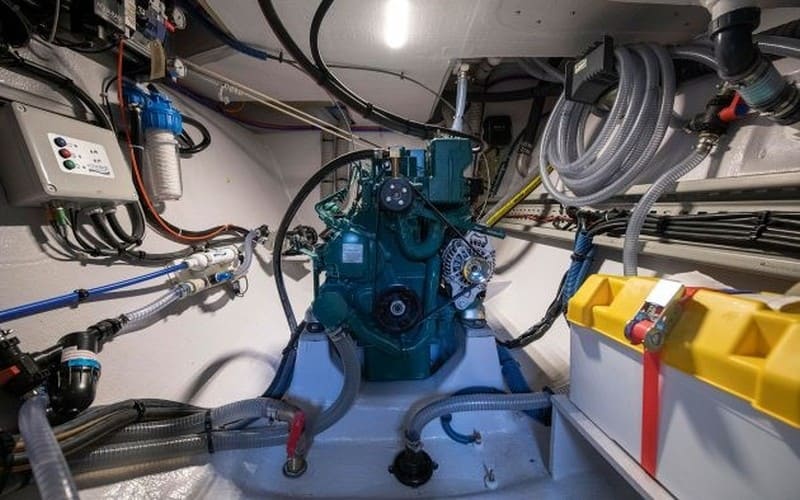
In the photo you can see that the engine and steering gear are shifted to the stern, and in the center there are water and fuel tanks, batteries and other equipment. We liked that most of the equipment is concentrated in one place, and not distributed throughout the yacht. Of course, this was done not so much for our convenience in service, but to achieve the most productive balance of the vessel, and this perfectly coincided with yachtsmen's ideas about serviceability.
In Cabins and Forepeak
On this boat, the forepeaks can be used for more than just storing fenders if the Neel 43 is intended for charters. There is plenty of room for the crew. Ten passengers can be perfectly accommodated in a trimaran if all the options for sleeping places are well utilized.
To visualize these options, let’s take a look at the Neel 43 passenger and crew layouts.
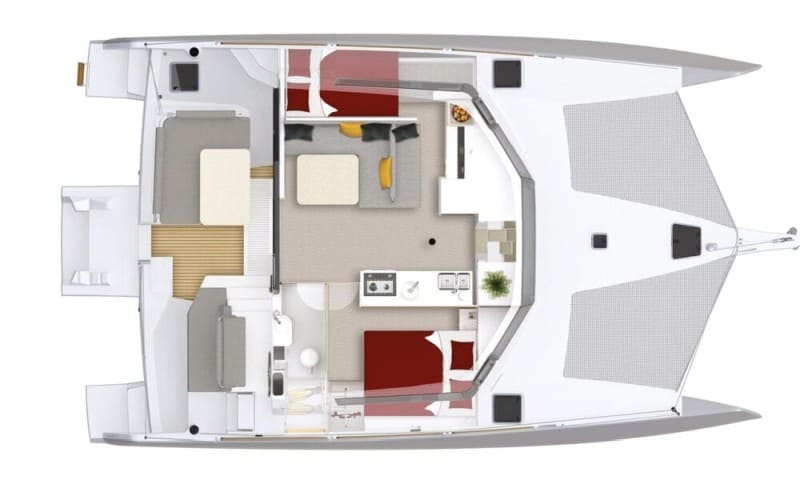
The first schematic shows the bedding option suitable for a cruise with 2-4 people. These can't even be called cabins - just places fenced off for sleeping on the loft deck. One of these places, at the navigator's table, we have already shown - it is fenced off only by a curtain.
The second one can be called the owner's cabin variation – you get a high and roomy space with a large double bed and many windows.
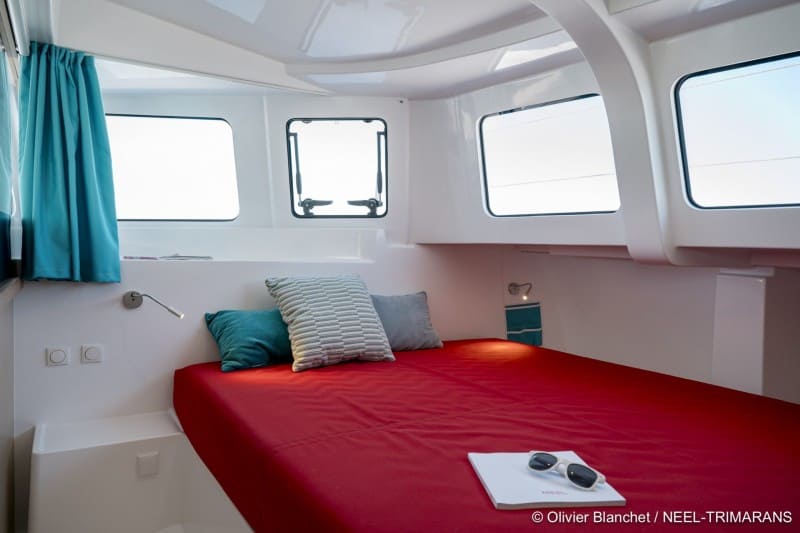
On the second schematic you see how it is possible to equip additional berths in the bow of the central hull and fore peaks.
The first berth is quite spacious, although it narrows somewhat towards the headboard, but the ceilings are high, and natural light is provided through the skylight and side porthole.
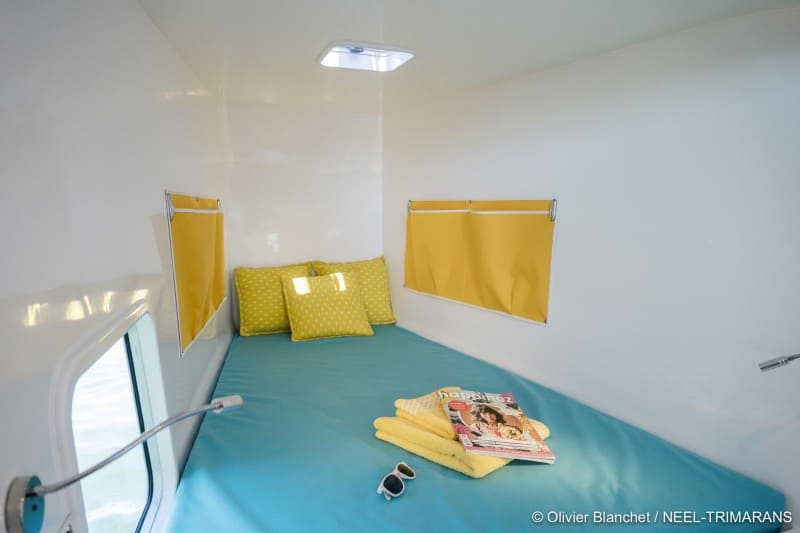
Living spaces in the forepeak are reserved for crew members - one berth per one person. And no, we were not mistaken: although there are only 8 beds on the diagrams, do not forget about the folding table in the cabin, which can be transformed into 2 beds.
Since we were examining the forepeak, we could not help but pay attention to the bow of the Neel 43.
This is how you can characterize the bow of this trimaran. Everything here is subject to expediency. The bowsprit is used to shift the center of sail and carry the sail armament forward.
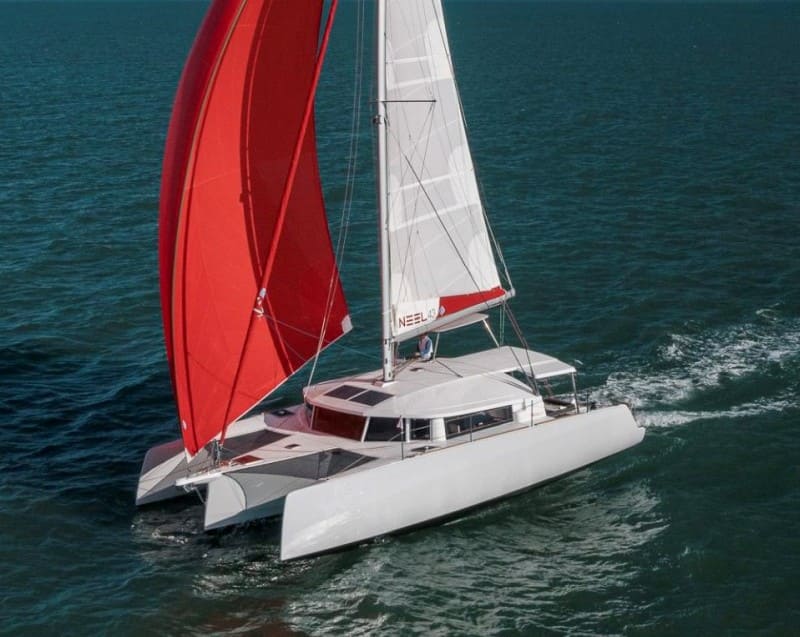
The nets between the noses of the hulls are not for the sake of sunbathing area here. They perform their direct function - they dampen the waves and do not allow the trimaran to bury its nose into the wave.
Advantages of Neel 43
Since we didn’t find much shortcomings, we will immediately announce the main one - there is no signaling equipment whatsoever warning you about the ingress of water into the engine compartment. So, it is necessary to either order such equipment on your own, or simply check the condition of the compartment more often. And here are the pros:
- High performance, excellent maneuverability.
- Obedience to the steering wheel and rudder.
- One rudder and an obedient helm provide a great helmsman's feel to control the sails.
- The quality of the hulls, which ensures the reliability and safety of being on board.
- Enough comfort for a cruise as a couple, as part of a family, with friends or a charter flight.
- Affordable price with great features.
The last point allows you to actively use this boat for commercial purposes.
Another advantage that we have noticed is that an experienced skipper is able to manage this beauty alone.
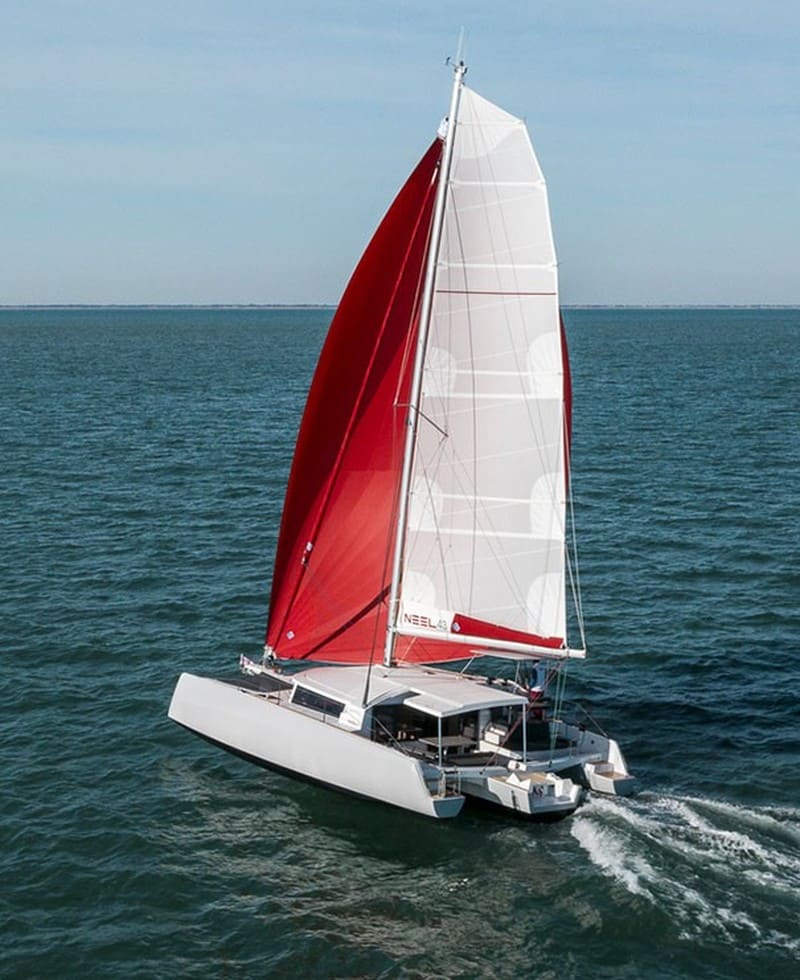
Reviews of Neel 43 from Professionals
Rupert Holmes and Dave Reed are well-known yachtsmen and journalists, who participated in the testing of the Neel 43 trimaran. And Dave did it as part of the Sailing World Magazine team, which conducted its annual test, seeking out the 2023 Boat of the Year nominees.

From the very first lines of his review Rupert Holmes immediately offers a solution for those who hesitate between a monohull yacht and a catamaran. Cruising trimaran Neel 43, according to the author, can be an ideal option. Rupert goes on to substantiate his claim.
A well-known journalist and yachtsman remembered the trimarans of the 60-70s, which did not quite justify their title of "cruising". In contrast, Rupert picks light and fast three-hull yachts of the last decades, the credit of the revival of which largely belongs to the Neel shipyard from La Rochelle with its cruising models with spacious rooms. Neel 43 trimaran designed by Marc Lombard is the discovery of 2021.
Test team with active participation of Rupert Holmes tested the Neel 43 at La Rochelle in light to moderate seas and 12-16 knots offshore wind.
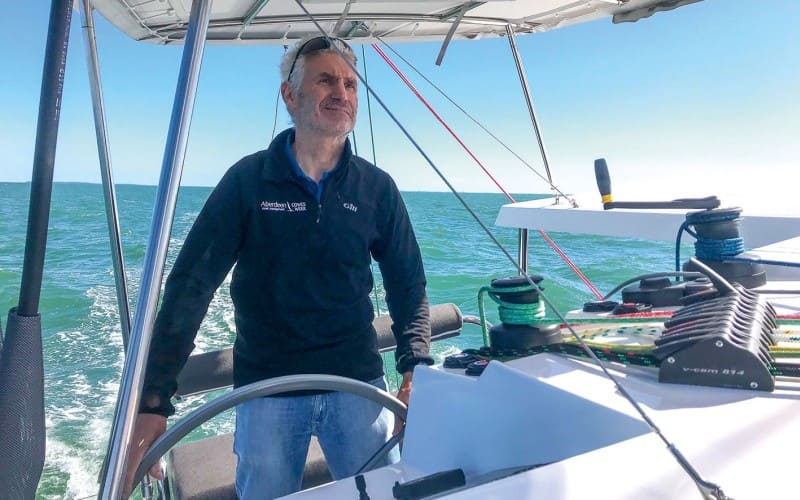
The journalist specifically noted that despite the spacious deck and massive roof, the Neel 43 is three tons lighter than most 42-foot catamarans. He was surprised by the low wetted area during maneuvers when windward ama rises out of the water. This area is several times smaller than that of a catamaran of the same size. In addition, the Neel 43 has a low displacement. Together, this makes the trimaran remarkably fast.
Then the author described in detail the trials of the boat under sail. The crew turned off the engine, hoisted the mainsail, turned the staysail downwind on the beam, and with a true wind of 14 knots, quickly accelerated the trimaran to a stable speed of 10 knots.
The change in true (65°) and apparent (40°) wind angles reduced the speed by just one knot. Rupert noted that if they had more advanced rigging rather than Dacron sails, it would add a few useful degrees closer to the wind without sacrificing speed.
The helm is connected to one rudder by straight cables. The steering was remarkably responsive during testing. At the same time, the direct sensations from handling it were much brighter compared to a catamaran.
Maneuvering was as easy as navigating a monohull. The trimaran turned deftly into the wind, and the speed rarely dropped below five knots.
Rupert Holmes explained how the developers achieved light and smooth movement of such a seemingly bulky vessel. They did an excellent job with the distribution of heavy equipment in the central building, concentrating it in the middle. Under the central hull of the trimaran, they placed one keel instead of two, as in most cats.
But in order to heel the trimaran at angles of more than 14°, great efforts are required - the boat quickly reaches stability. The high freeboards also provide a large margin of buoyancy in the amas, even with a strong gust of wind or a squall.
A single fin keel makes it impossible to beach the trimaran like most cruising boats.
Since the trimaran was heading towards the wind from the canal into the open sea, we found out how easily controlled underwater elements behave during motor navigation. With one 50 hp engine and 2400 rpm the boat was moving at a speed of 8 knots.
When turning downwind the asymmetric kite was raised, since the speed at a true wind angle of 150° began to decrease. This maneuver made it possible to raise the speed to 9 knots, and the best VMG downwind was 7 knots.
When the wind increased to a true speed of 15-16 knots, the crew deviated from the true wind up to 115°. The boat accelerated to 10.5-11 knots. At the same time, Neel 43 demonstrated excellent stability: no change in roll was noticed.
Concluding his review, the journalist and yachtsman noted that the Neel 43 has become a cruising trimaran concept for the mass market. The popularity of triple-hulled vessels is evidenced by the fact that the shipyard produces at least two trimarans every month.

Test team loved the new concept of Neel's latest trimarans, which consists of one large connected living space that is visible from float to float. Wherever you are on this ship, you feel your involvement in the overall life process, as in any residential family building.
There is only one "sunken" living space for passengers - in the bow of the central float. All other berths are located on the same level as the saloon and cockpit, which distinguishes the Neel 43 from most catamarans and many trimarans from other manufacturers.
Although the trimaran is primarily intended for family sailing, it should be the family of the yachtsman who prefers high performance boats.
It was no coincidence that the gigantic, according to the shipyard, mechanical compartment below was especially noted. It is only necessary to open the hatch in the saloon and descend into a spacious and well-lit area, where free access to all trimaran systems is provided.
Dave Reed quotes Chuck Allen, the senior judge of this competition, who notes that the trimaran is more stable and faster than a catamaran, as a result of which the pleasure of driving it is much higher. Riding a trimaran is a great experience. The adjustment of the amas becomes similar to balancing, which is provided by the rudder, mast and keel in the central hull. At the same time, there is no strong roll, the trimaran is very stable. "It's an adventure platform," Chuck Allen summed up.
He was surprised that a trimaran sails against the wind like a monohull sailboat, and when it glides over a wave, it simply takes off. “I got the impression that you can really sail on the coast with the right selection of sails,” Chuck jokes.
He noted that this trimaran was easily handled by two people at high speed and expressed his confidence that the crew of 4 would be great in a coastal race.
The team of judges noted the good location of the steering wheel on a starboard raised platform, which ensured good visibility. They also liked the fact that all reefs and sail control cables run close to the helm and are folded into special bags.
It was noted separately that the shipyard commits to environment protection technologies through the use of environmentally friendly and recyclable materials, in particular, epoxy resins, foam plastic, and cork. To power the refrigerator and electronic devices, solar panels are provided on the roof of the trimaran.
Video Reviews of Neel 43
Prepare to enjoy the trimarans beauty in video format!
Let’s start with well-known Multihull Solutions – their video review in comprehensive and interesting at the same time:
Moving on to Aeroyacht and their in-depth 22-minute-long review:
Another great yachting test at the sea by Multihull World:
And, if you are not interested in commentary, here’s a silent interior review of this roomy boat:
All of the above information leads us to the following conclusion: Neel 43's affordable price, its excellent seaworthiness, stability and reliability, ease of handling make it desirable for many sailors, including:
- couples who love the speed and challenges of sailing;
- friends ready to strengthen the bonds of friendship in sea trials;
- families with or without children who want to spend time together without the presence of strangers on board;
- lovers of the sea, speed and sails;
- yachtsmen who do not like excessive luxury, but do not want to completely deprive themselves of comfort.
In addition to private ownership, this trimaran is ideal for commercial purposes. It can be successfully rented out both to passengers who never met each other before the charter, and to groups of friends or colleagues.
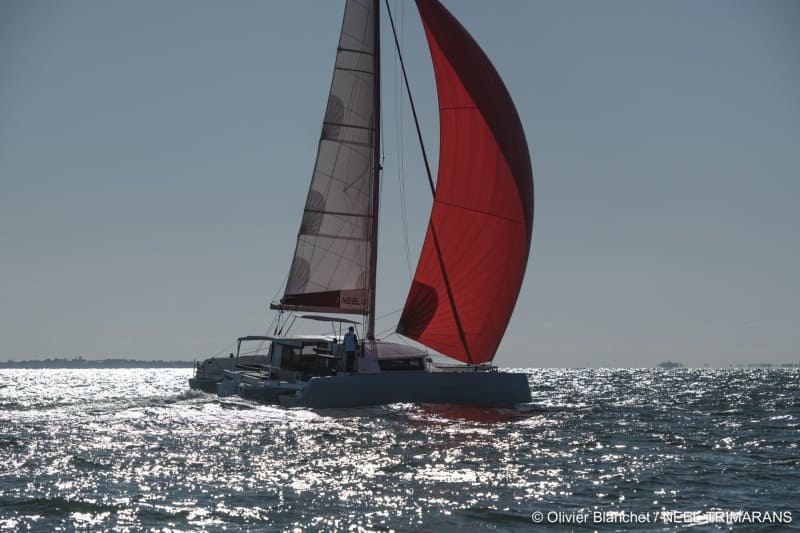
Price calculator
Where to buy neel 43 at a bargain price.
If you are reading this, you already know the place where you can buy the Neel 43 for a low price without the risk of receiving services or accessories that you do not need.
All marketplace employees topRik have been and regularly go to sea on motor and sailing yachts , monohulls and multihulls. We all know perfectly well what needs to be done so that your boat fully meets your requirements, and also that you do not overpay for imposed options.
If you put your trust in us, then all you have to do is state your requirements, consult our team and wait for us to deliver your yacht to its destination.
We will take on:
- negotiations with the manufacturer;
- control over the package options of the boat;
- trimaran delivery;
- providing the missing equipment and accessories from rigging equipment to a watermaker ;
- further maintenance of the boat.
If you are a novice yachtsman, before going to sea on your own, you can enroll at our skipper school SimpleSail to receive "International Bareboat Skipper" after finishing IYT Yacht Training Course .
Call, send an e-mail or contact our consultants using the website feedback system.
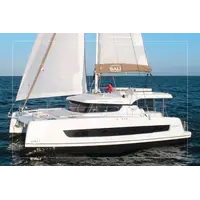
- Glossary of Nautical Terms
- Law & Rules

- Profile details
- Comparison list
- Gift certificates
- Terms of Use
- Privacy Policy
- Refund Policy
- Tallinn, Valukoja 8/2 (Regus Offices)
- +37253060890
- Mon-Sun 10.00 - 18.00
- [email protected]
- View on map
- Leave feedback
- Dragonfly Service
- Dragonfly 1200
- Dragonfly 920
- Factory Tour
- Backstage Videos
- Dragonfly Sail Guide
- Try before buy
- Dragonfly-Training & More
- Newsletter Archive
- Clubs & Associations
- Customer stories
- Merchandise
- Privacy Policy
- General Terms of Sale
NEW Dragonfly 36
Design & performance.
- Reviews & Awards
Specifications
- Photo & videos
Maintenance

This remarkable sailing trimaran stands out with its new innovative wave-piercing main hull design, ensuring smooth and efficient sailing. With a strong emphasis on easy handling and shorthanded sailing, the DRAGONFLY 36 is perfect for families and sailing enthusiasts alike.
Step aboard and experience the spacious cockpit that invites relaxation and social interaction, complemented by a stylish, modern interior that seamlessly blends comfort and practicality. This exceptional cruiser/racer sets a new standard for offshore sailing, prioritizing both safety and family-friendly features, making it an ideal choice for unforgettable voyages.
Join the next generation of sailors with the DRAGONFLY 36, where performance meets elegance and every journey becomes a memorable adventure.

NEW Dragonfly 36 Videos
The new DRAGONFLY 36 Performance Cruiser, a cutting-edge sailing trimaran where innovative design seamlessly integrates with exceptional functionality, all specifically engineered for those who crave adventure on the open seas. This remarkable cruiser/racer has been meticulously crafted for both seasoned sailors and adventurous families, standing out with its pioneering wave-piercing main hull and float design. This unique feature not only enhances the DRAGONFLY 36's aesthetics but also significantly boosts its performance by more buoyancy in the bow and also allowing for more smooth, safe and efficient sailing, even when navigating through choppy waters or adverse weather conditions.
The unique and revolutionary DRAGONFLY SWING WING system – introduced 35 years ago – reduces the 8.12 m beam to only 3.7 m in seconds, using no tools. The DRAGONFLY 36 introduces for the first time an all-composite high-tech construction, making the DRAGONFLY SWING WING system simpler, lighter, stronger and easier to maintain.
The DRAGONFLY 36 steps into a new era in construction and design at Quorning Boats in Denmark, where more composite engineering is implemented in the structural design. Many fine element calculations backed up with physical strength tests to ensure a stronger and homogeneous construction by also using more infusion and complex tooling for the composite parts. All this to optimize production, weight, strength, lifetime and maintenance and at the end also for lower costs. The DRAGONFLY 36 has been over 2 years in development and is a high tech quality construction in all details.
The DRAGONFLY 36 is engineered to excel in a variety of sailing scenarios, from spirited weekends on the water to long-distance offshore cruising. With its lightweight construction and expertly calibrated sail plan, this cruiser is designed for easy handling—making shorthanded sailing accessible and enjoyable. Whether you’re a solo sailor, a couple, or a family of four, the DRAGONFLY 36 simplifies the sailing process, allowing you to focus on the thrill of the adventure rather than the complexities of handling.
The DRAGONFLY 36 will be available in two versions, both with carbon masts. The TOURING version with self-tacking jib system and the PERFORMANCE version with a taller rig and larger overlapping furling headsail.
Step aboard and immerse yourself in the spacious cockpit, an inviting area designed for relaxation, social interaction, and enjoying the breath-taking views. Featuring comfortable seating with all lines and sail-handling-gear lead towards the twin helm wheels, without interrupting the people relaxing in front. The cockpit becomes a centerpiece for shared laughter and memorable experiences as you sail together with family and friends.
The modern, stylish standard ash (optional elm) interior has been carefully thought out to incorporate both comfort and practicality, with features like a fully equipped galley, multifunctional living spaces, and extensive natural light flooding through the boat. The design encourages a sense of togetherness, whether you’re preparing a meal or sharing a sunset view over a glass of your favorite beverage.
The onboard experience is enhanced by storage solutions and an ergonomic layout, allowing for a clutter-free environment. This attention to detail extends to the interior finishes, where high-quality materials meet aesthetics, creating a warm and inviting atmosphere that makes you feel at home, no matter where your journey takes you.
Join the next generation of sailors with the DRAGONFLY 36 Performance Cruiser. Whether embarking on a spontaneous day sail or planning an exhilarating long distance voyage, this sailing Trimaran redefines the standard for performance cruising, empowering you to explore the beauty of the open water with confidence, comfort, and unparalleled style. Experience a sailing lifestyle that goes beyond mere transportation, as each moment aboard the DRAGONFLY 36 becomes a cherished memory waiting to be created.
Reviews, articles & awards
Dragonfly 36 touring and -performance.
To inform and illustrate recommended service, maintenance, and refitting on an older Dragonfly, we have drawn this general information sheet. Rough elements, like strong winds and wave conditions, strong saltwater and UV do have some impact on the boat after a long sailing life.
We strongly recommend servicing and changing vital parts on your boat according to our recommendations.
This information overrules any former information you may have, as the following is based on updated knowledge.
Exchange intervals of structural parts:
- Waterstays - every maximum 10 years and or by 25.000 NM. Made in special Dyeform, Python and or Compacted Strand cable quality.
- Side stays and forestay cables – every maximum 10 years or 20.000 NM. Made in Dyeform, Python and or Compacted Strand cable quality.
- Fiber Side stay cables (optional) to be replaced after 7 years and or max 20.000 NM.
- Diamond stays on the mast should be changed after 15 years at the latest, or, by max 25.000 NM. Made in Dyeform, Python and or Compacted Strand cable quality.
- Beam stop cable to forward, outside beam under trampoline – every maximum 10 years.
- Steering cables – every maximum 7 years and or by 15.000 NM. Regular visual control is strongly recommended and especially before planning longer trips.
The above listing of exchange intervals is the recommendations from the Dragonfly yard, and it is not an extension of the 2-year warranty.
Halyards and Dyneema lines need regularly visual check for wear and tear.
From January 2024 we engrave the Dragonfly logo including a production year, on all rigging terminals on structural wiring such as waterstays, side stays and diamond cables, to make it easier for you as a customer to follow the above recommended exchange intervals.
Always check very carefully that you replace cables in the VERY same type of cable quality if not ordered/replaced by the Dragonfly Yard.
Visual check of all cables is still required before and when changing the rigging. We strongly recommend focusing on side stay cables, as these easily can be bend when stepping the mast. Bended side stay cables near the terminal may cause the side stay cable to break.
On all Dragonfly’s, please regularly check the forestay cable in the top by the terminal. When furling, the spinnaker or Code-0 halyard may block the forestay, which can cause failure of the forestay cable.
Trampolines:
On all Dragonfly’s, we recommend re-stitching (sewing) along the stitching/seams of the trampolines every 6-7 years (in climates with strong UV, every 5 years). Normally, our clients change their trampolines after 10-12 years use. Please note this is a recommendation and it is still always the skipper’s responsibility to regularly check the condition of the trampolines.
Float deck Teflon pad rings:
The white 5 mm Teflon pad rings on the float deck needs to be changed every 13-15 years – this is neither critical nor structural. For easy change of these pads/rings, you just bolt off the floats from the wings by the one bolt in each end of the Wing/beam.
Quick-Links:
Over many years, Quorning Boats has used the riggings links, so-called Quick-links, in the Dragonfly production quite often. When replacing these Quick-links, it is of utmost importance to purchase links of same high quality or similar products carrying same strength (working load). Many products look the same, but do NOT carry the same strength/loads. If you are not sure about this, please contact your local dealer or the Dragonfly Yard.

Caution for all painted surfaces on the boat and mast.
Painted surfaces may NOT be covered with Plastic or other non-breathable materials, as water and condensation cannot be lead away from the painted surfaces, and these are not able to dry.
When water is stuck between the Paint and a non-breathable or non-ventilated material, blisters can occur between the paint and the gelcoat or the carbon sections of the mast.
Due to these circumstances, the permanent use of Ex. Matt-Fenders (long flat fenders) cannot be recommended, as water and Condensation can also get stuck between these and the hull, and lead to blisters in the Paint.
Quorning Boats cannot be held responsible for Blisters in the paint occurred due covering the painted surfaces with non-breathable materials.
Ordering Parts:
Original spare parts can be ordered at Quorning Boats at [email protected]
Common spare parts can be shipped within one or two weeks, whereas special parts and/or custom-made parts usually are served within 6-8 weeks.
Parts ordered at Quorning Boats Denmark, will be produced in originally designed materials. Should you choose to order from other suppliers, please check that the same kind of materials are used – especially on the waterstays and other rigging parts, where stronger special Dyeform, Python and or Compacted Strand cables are needed.
All other normal maintenance for like engine, pumps, electrical systems etc. we refer to the guidelines from the manufacturer of these specific products.
| SPECIFICATIONS DRAGONFLY 36 | TOURING | PERFORMANCE |
|---|---|---|
| LOA sailing | 11.55 m | 11.55 m |
| LWL, centre hull | 10.90 m | 10.90 m |
| Length folded | 13.43 m | 13.43 m |
| Beam sailing | 8.12 m | 8.12 m |
| Beam folded | 3.70 m | 3.70 m |
| Draft, board up | 0.67 m | 0.67 m |
| Draft, board down | 2.00 m | 2.00 m |
| Weight of standard dry boat, sail ready excluding extra's | 4.500 kg | 4.500 kg |
| Max total weight, all included incl. crew | 6.700 kg | 6.700 kg |
| Max total weight, all included, excl. crew | 6.000 kg | 6.000 kg |
| Water capacity | 200 l | 200 l |
| Fuel tank | 70 l | 70 l |
| Holding tank | 60 l | 60 l |
| Engine, standard | 30/21.3 HP/kW | 30/21.3 HP/kW |
| Engine, optional | 40/29.4 HP/kW | 40/29.4 HP/kW |
| Mast section, carbon | 16.50 m | 18.50 m |
| Mainsail | 60 m² | 70 m² |
| Self-tacking jib | 20 m² | (25) m² |
| Furling genoa | (30) m² | 38.5 m² |
| Furling Code-0 | 60 m² | 72.5 m² |
| Gennaker | 110 m² | 150 m² |
| Bowsprit, fixed length | 0.90 m | 0.90 m |
| Max. No of persons for CE-Category B | 7 | 7 |
| Max. No of persons for CE-Category A | 5 | 5 |
| Unsinkable | Yes | Yes |

Check out the other dragonflys

Dragonfly 25

Dragonfly 28

Dragonfly 32

Dragonfly 40
Dragonfly newsletter

Find a dealer
Find your local dealer
Quorning Boats ApS
Skærbækvej 101 7000 Fredericia Denmark
+45 7556 2626
VAT No DK 18 88 83 78
Dragonfly 36
- Previous models
Quick links

Address 11,Cove Drive, One 15 Marina Club, Singapore 098497
Phone +65 9155 4060

A Comprehensive Guide & Introduction to Trimaran Yachts
When it comes to sailing boats, there are several options to choose from, including monohull boats, cruising catamarans, and multihull boats such as catamarans and trimarans. While catamarans are a popular choice due to their spaciousness and stability, trimarans offer some unique advantages. With three hulls instead of two, trimarans like the Corsair 880 and Rapido Trimaran have a wider beam, which can help increase speed and stability in high winds.
Additionally, trimaran sailing techniques can differ from those used on catamarans due to the placement of the centerboard and the differences in the hull shape. In fact, trimarans can be faster than catamarans in certain conditions, as the wind speed doubles between the sails, creating more lift. Ultimately, the choice between a catamaran and a trimaran will depend on the sailor’s preferences and intended use.
When it comes to choosing a sailboat, there are many factors to consider, including boat speed, comfort, and cost. Trimarans have become increasingly popular due to their speed and stability, and the Dragonfly 32 Trimaran and Strike 18 Trimaran are two great examples. The Neel Trimaran line, including the Neel 43 and Neel 51, offer even more comfort with their aft cabins and spacious designs.
However, the cost of these larger trimarans can be significant, and buyers may want to consider a basic boat incl from Quorning Boats or even a used Neel Trimaran for sale. Ultimately, the right choice depends on the buyer’s priorities, but all trimarans offer the advantage of being able to sail faster than the apparent wind due to their multiple hulls. Whether testing a new model or enjoying an established design, a trimaran is a fantastic choice for sailors looking to maximize their speed and stability on the water.
Give it up for the multihull sector of the boating industry.
Any industry insider will easily see how fast growing that sector currently is. In fact, it is the fastest growing sector if the number of new cruising boat manufacture and sales is anything to go by.
Far from the prejudice of the earliest days, multihulls now seem to be the in-thing and you don’t have to look far away before you’ll see the next catamaran, trimaran yacht for sale.
Sales of catamarans are booming with each passing day. Trimarans, on the other hand, are like a niche within another niche.
Most trimarans are high performing vessels. These sailing yachts are usually designed for purposes ranging from racing to recreational use. This article will provide readers with a brief but comprehensive introduction into the world of trimarans.
So, what then is a trimaran boat in the first place?
For anyone looking for an exciting and versatile sailboat, the aluminum trimaran is a great option. One of the most popular types of trimaran boats is the Piver trimaran, which is known for its stability and maneuverability on the water. The Piver trimaran features three hulls, with the middle hull being the largest and most stable.
This design allows for smooth sailing and comfortable overnight cruising, making it a great choice for those looking to spend a weekend or longer on the water. The aluminum construction also ensures durability and low maintenance, making it a cost-effective choice for sailboat enthusiasts. Whether you’re a seasoned sailor or a beginner, the Piver trimaran offers a unique and exciting sailing experience that is sure to impress.
What is a Trimaran Yacht?
According to Wikipedia, a trimaran is also known a double outrigger. Trimaran yachts are multihull yachts comprised of the main hull and two other smaller outrigger hulls (which may also be called floats).
These three parts are the basic components of every trimaran sailboat. Each of the outrigger hulls is connected to the main hull with lateral beams.
While most trimaran yachts are usually sailing yachts designed for recreational and racing purposes, some others are still designed to be used as ferries and warships.
(NOTE: Have you been looking for a Trimaran Yacht? Check out this 2006 Racing Trimaran Tantrum Too , a fun & fast competitive seaworthy racer & offshore cruiser. Winner of the ‘2018 Bintam Trophy’ and holder of ‘Around Bintam Record’. Learn more here! )
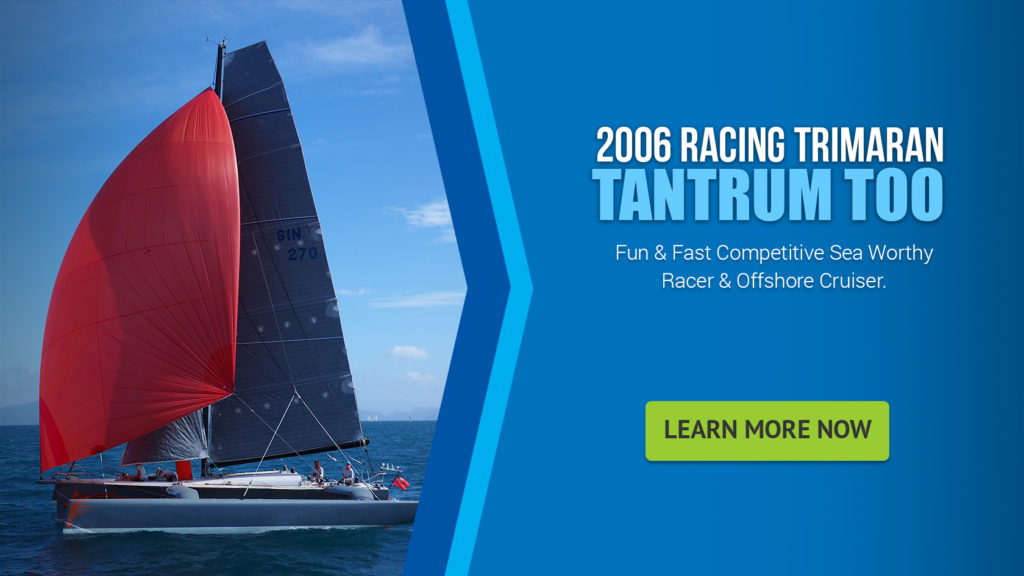
The name trimaran was coined from ‘tri’ and ‘maran’
The ‘trimaran’ name has its origin in two words. It was formed from ‘tri’ and ‘maran’. While ‘tri’ means three, the ‘maran’ part means wood or tree.
Trimarans have a kind of interesting design and architecture that makes them exceptionally fast and powerful. It is thus the preferred vessel for most lovers of speed and water adventure.
Read more: What is the best hull material for a houseboat ?
Trimarans have been around since 2000 BC
Although today’s popular sailing trimarans did not get mainstream acceptance until the 60’s and 70’s, these vessels have been in use and existence long before global acceptance, dating back to about 2000 BC.
In fact, the earliest trimarans are still very much in use today.
The development started with the Austronesia people.
Today, traditional fishermen of the maritime region of Southeast Asia, Micronesia, Madagascar, as well as, the Polynesia regions still use trimaran sailboat similar to the first trimarans.
Trimarans are composed of three main parts
We’ve mentioned this in our description of what a trimaran yacht is.
Every trimaran would have a main or center hull and then two other small outrigger hulls attached to the center hull with lateral beams.
These three components form the basic design for all trimarans and modern trimaran sailboat designs always take this trimaran base.
The center hull is the main hull and is also known as vaka. The two stabilizers on the sides are known as the outrigger hulls, or ama(s).
The main hull offers the most buoyancy
The amas are mainly there to offer more stability to the vessel. Most of a trimaran yacht’s buoyancy is provided by the center or main hull.
This arrangement no doubt offers more flexibility to the design.
Because there is usually a wide separation between the hulls, the trimaran yacht requires only a little buoyancy to keep the yacht stable. This reason is why you’d rarely find trimarans having their outrigger hulls or amas in the water.
Trimarans offer better stability and a super stellar performance
Trimarans, when compared to catamarans which are composed of only two hulls, are more stable.
They offer a better stability and a stellar performance which have even been improved with new technologies infused into the design of these boats.
Trimarans are lightweight and are the preferred choice for boat aficionados and connoisseurs.
The stellar performance advantage which is made possible by the design makes trimarans some of the fastest boats when it comes to yacht racing.
They are perfect for sports sailing and are often winners in water races and competitions.
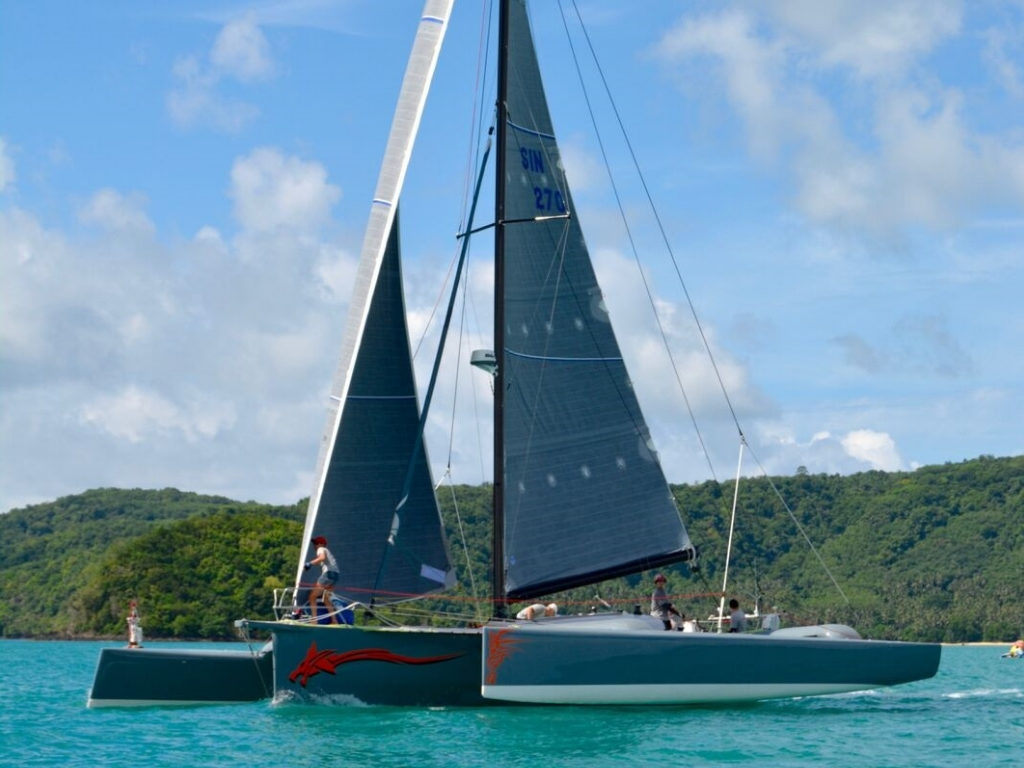
Different types of trimarans
There are basically just two types of trimarans. These are the regular trimaran and the open trimaran.
Instead of plating, the open trimaran rather has a trampoline in between the hulls.
Trimaran yacht advantages over monohull yachts
When compared to single-hulled yachts, trimarans no doubt have some advantages. Some feature differences also exist.
A trimaran, when compared with a monohull of the same length would have a shallower draft. It would also have a wider beam and a less wetted area.
The trimaran though will be able to fly more sail area compared to the single-hulled yacht.
Because of the wider beam, the trimaran has a better straight-line performance when compared with a monohull.
The trimaran can sail in shallower waters and can still perform well while maintaining its stability in the face of stronger winds.
Trimarans are almost unsinkable
Trimarans have a kind of design that is considered almost unsinkable.
This is because even when it is filled with water, the buoyancy of a single outrigger hull or ama can easily keep the entire yacht afloat.
The ama offers greater resistance to the boats and unlike monohulls, trimarans rarely sink.
Because of the high level of safety and stability, sailors with restricted mobility often prefer some special types of trimarans.
Trimarans are like the bridge between catamarans and monohulls
Catamarans, as well as monohulls, have their areas of excellence. Nevertheless, trimaran yachts have certain capabilities which have made them seem like the bridge between monohulls and catamarans at which there is little or no compromise.
Trimaran sailboats are excellent for high speed.
Trimarans generally have moderate weight carrying capability, moderate space below the main deck, and a larger deck area.
The cross deck design between the amas and the main deck is another advantage.
Catamarans usually have large empty gaps in their cross deck bridges.This complexity then necessitates the need for stronger structures, implying more weight, and higher costs. A trimaran yacht would usually have a much smaller cross deck.
There will be a shorter gap between the hulls and the empty space would not extend through the entire yacht’s length.Because of these, less structural weight is required and heavier loads can also be carried on the cross deck.
While catamaran and trimaran yachts are usually built for different purposes, the most obvious difference out of racing is usually the center hull.The center hull of a trimaran yacht will be much larger than the catamaran hulls.
Trimarans are easy to trail, they have a kind of superior handling and are easier to tack, compared to catamarans.
They are easy to manhandle ashore due to their lightweight design.
The lightweight design also makes it easier to use small and inexpensive engines when motoring. With a trimaran yacht, you’d be getting a stellar performance that will get you higher speeds.
If you want more excitement and thrill, perhaps a trimaran yacht such as the racing trimaran Tantrum Too will be very much suitable for you. Tantrum Too is a 12.7m trimaran yacht designed as a concept yacht for a fast ocean cruiser and cruising trimaran.
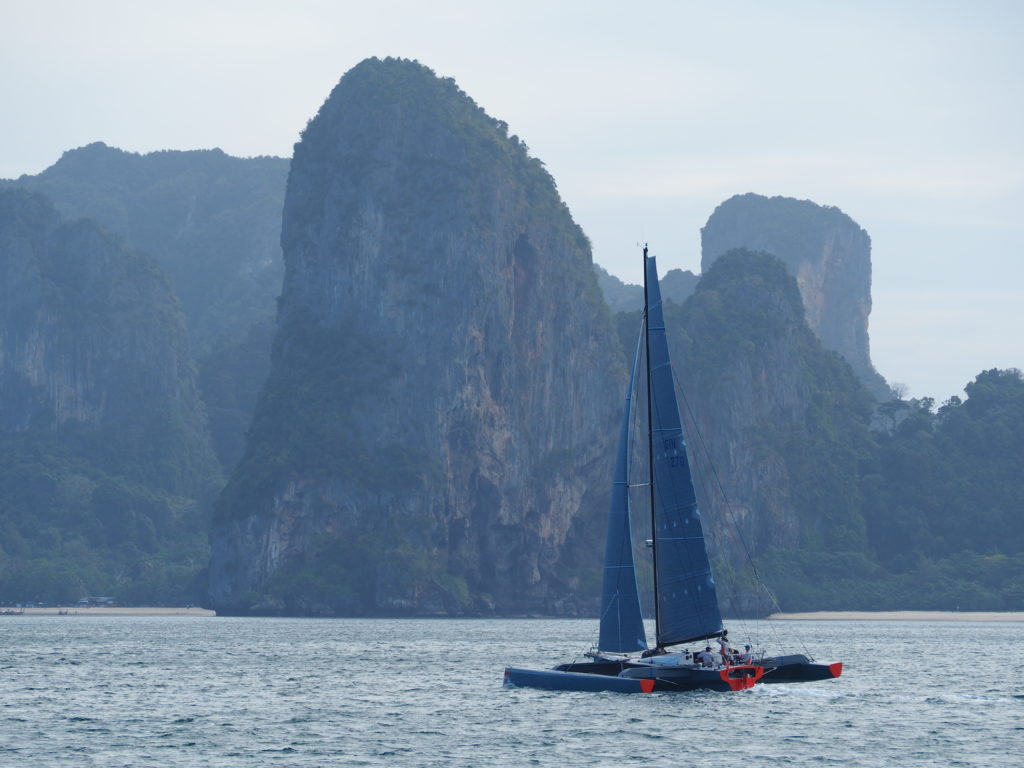
If you’re in the market for a good buy, the trimaran yacht for sale is currently available on auction. You can register here so you can tender your bid for this cruising trimaran.
The purpose of this article is not to pick the better yacht between a trimaran yacht and a catamaran, or a trimaran and a single-hulled boat.
Each of these different watercraft has different areas where they excel. Your choice will most likely have to do with the purpose for which you’re buying.
If you’ve discussed with your sailing crew and have decided to choose a trimaran as your next yacht, all well and good, you’re in for a lot of thrills and fun.
Recent Posts:
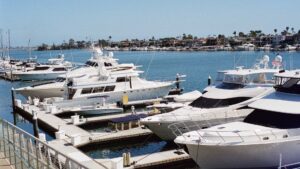
Common Mistakes to Avoid When Buying a Used Boat

Eight Spectacular Boats Awaiting New Owners This Month

Your Ultimate Guide to Yacht Financing in Singapore
Academia.edu no longer supports Internet Explorer.
To browse Academia.edu and the wider internet faster and more securely, please take a few seconds to upgrade your browser .
Enter the email address you signed up with and we'll email you a reset link.
- We're Hiring!
- Help Center

Hydrodynamic Optimisation of High-Speed Trimaran Hull Forms

Related Papers
Stefano Brizzolara
J. Mikkelsen
This paper investigates a systematic series of high-speed trimaran hull forms. Trimaran vessels are currently of interest for many new high speed ship projects due to the high levels of hydrodynamic efficiency that can be achieved compared to mono-hull and catamaran hull forms. The core of the study involves determining the wave resistance for each model in the series in conjunction with varying longitudinal side hull locations. The methods employed to determine the wave resistance of each trimaran model comprise of computational fluid dynamics (CFD) suite SHIPFLOW, theoretical slender body theory and experimental investigations. The trimaran hull forms are transom stern high-speed displacement hull form vessels possessing moderately high L/B ratios. A wide variety of data was acquired due to the parametric space and various side hull locations. As a result, these data shows clear trend from which accurate assessments could be made. Results presented in this paper offer considerable...
The paper presents a linear boundary element method and its applications for the study of the wave resistance of high speed mono-and multi-hulls with automatic prediction of dynamic trim and sinkage. A review of some assumptions used in the method is given in the paper and some alternatives are introduced and tested. One closed stern hull and two kind of fast displacement round bilge hulls, with transom stern and stern wedge, have been chosen as reference vessels in the study. Presented results include the comparison with experimental available data of wave resistance and dynamic attitude, wave profiles along the hull and behind the transom, and dynamic pressure distribution on the hull. The accurate prediction of the dynamic trim and pressures at the stern of high speed hulls with stern wedge by means of possible extensions to the linear theory are introduced in the paper. Effects of the use of dipole distributions on the hull and in the wake have also been discussed for the case o...
International conference on ship and offshore technology, IIT Kharagpur, Dec 2015.
Kareem Khan
Future surface combatant designs are focused on multirole mission capabilities and unconventional efficient propulsion systems. Concepts in naval design and related systems introduced by several nations in the past two decades shows great amount of advancements from the traditional platform operation criteria such as speed, shock & noise reduction, infrared signature to futuristic demand criteria like flexible mission capability, alternative propulsion architecture, higher degree of stealth, longer duration of loitering capability with smaller crew and cleaner emissions. Few of such platforms are already in operation and many more are under design/construction phase by the world navies. Mission effectiveness of the platform largely depends on two major entities i.e. hull form and propulsor configuration. It has been reviewed that most of advanced marine vehicles rely on unconventional propulsion such as waterjets & podded propulsors for effective platform performance. Studies have been carried out at Naval Science & Technological Laboratory (NSTL), India on a trimaran with waterjet propulsion for hydrodynamic performance evaluation at concept level. The present paper highlights the hydrodynamic studies on trimaran with waterjets carried out at NSTL.
Vikrant Kumar
RELATED PAPERS
International conference on ship and offshore technology, IIT Kharagpur, Dec 2013.
Kareem Khan , Praveen PC
Journal of Ship Research
Igor Mizine , Eduard Amromin
abbas mohammad
Scientia Iranica
Amin Nazemian
Mustafa Insel
Ahmed Osman Alaghbash
Lawrence Doctors
Miguel Santos
E3S Web of Conferences
Wiwin Sulistyawati
mohammad javad ketabdari
Proceedings of 26th Symposium on Naval Hydrodynamics
Proceedings of Symposium on Analyses of Strongly Nonlinear Flows around Moving Boundaries
Proceedings of 9th International Conference on Numerical Ship Hydrodynamics
karim akbari
Journal of Marine Science and Engineering
Simone Mancini
IRJET Journal
Journal of Marine Science and Technology
Emilio Campana
Ports 2007 Conference, …
BRUCE HUTCHISON
Ocean Engineering
shahjada tarafder
Apostolos Papanikolaou
Md. Al Amin Miazee
The Institution of Engineers, India Sep 2013.
teresa castiglione
Ship Technology Research
EDITOR IASET
International conference cum exhibition: Tech Samudra, IMU, Dec 2012.
Konstantinos Kontogiannis
Brodogradnja
Prasanta Sahoo
Andrea Di Mascio
RELATED TOPICS
- We're Hiring!
- Help Center
- Find new research papers in:
- Health Sciences
- Earth Sciences
- Cognitive Science
- Mathematics
- Computer Science
- Academia ©2024

Where does the base for most new design work come from?
A reader recently asked, "Are there any rules or formula to follow when starting a new boat design or are they created more by eye and experience? If the former, can you briefly explain what they cover and historically where they came from?"
This is an interesting question but one that could fill several volumes if answered in detail! However, Here is an abridged overview of the situation and where we came from. First, let's take a brief look at the historical base of modern naval architecture.
Ships and boats have been around for LONG time. Their design was then indeed one of eye and limited experience. But a few thinking people tried to learn the effects of various changes in hull shape through model testing—and a couple of famous names come to mind.
Around 1500, Leonardo di Vinci reportedly made 3 models and tested them, while one of the first known Americans was Benjamin Franklin in 1764. But it was a William Froude in England who was the first to discover a way to correctly upscale the model data for full size craft. He was born 200 years ago, on November 28th 1810.
Froude's initial involvement with ships was to study dynamic stability but then he got a commission to try and create more efficient hull shapes. The Admiralty funded the first test tank in his home town of Torquay, UK (1872) and he was soon testing models and devising a way to compare them with the full scale ship—now known as his Law of Comparison and involved the now famous 'Froude Number' or Fn.
In its dimensional form, Fn is also known as the Speed/Length Ratio and is equal to Velocity (in knots), divided by the square root of the Waterline Length (in feet). It's really worth remembering this ratio, as it enables floating boats of vastly different sizes to be compared, as far as many of their characteristics are concerned.
Between 1868 and 1874, Froude went on to test all sorts of hulls and the first 'bible' on ship design was written based on many of his discoveries. Although more recent tests throughout the USA, Europe and now even Asia, have further refined the data, Froude's principles have basically remained intact.
He created numerous Coefficients as ways to compare different shapes and tested displacement forms with varying proportions and ratios. He also did a series of tests on flat planing surfaces with steps in them, spurred by ideas from a Rev. Ramus. He also discovered that hull resistance was primarily made up of two components that varied independently from each other… namely frictional resistance and wave-making resistance and devised ways to calculate each from model tests. For the former, he did an extensive series of tests with surfaces of different types to establish frictional coefficients that are still considered valid today.
Around 1886, a man named D.W. Taylor, a graduate from the US naval academy, went to England to study at the Royal Naval College and learned of Froude's work.
Once back in the US, he had Washington build an even larger test tank (1900) and then conducted a more extensive series of tests with an updated ship form, now known by naval architects world wide as the Taylor Series .
Later, a systematic series for classic planing hulls were conducted in England and called the Series 62 and these covered a fairly wide range of lengths and breadths.
In 1900, there were only 5 known model test tanks in the world. But there are now over 100, so many other Test Series have followed, and each provides a wealth of information for naval architects worldwide, as to what effect various proportions have on resistance, dynamic stability and sea kindliness.
One of the first test series to interest multihull designers was one presented by E.P. Clement in 1961, covering the test results for planing catamaran hulls . Although there is no time or space to discuss any of these tests here, many of them are now available on the web.
As far as modern multihulls are concerned, perhaps no one has used model test data more extensively than the renowned UK designer John Shuttleworth, and his early trimaran Brittany Ferries GB once held the cross-Atlantic record.
Editors note: See Interview with John Shuttleworth in this INTERVIEW section, also available via the HOMEPAGE.
Formulae and Coefficients
As noted above, the Froude Speed/Length ratio is very significant in boat design. Most descriptions and findings re hull resistance are directly related to it. For example it has been shown that a displacement hull creates a wave equal to its length at a S/L ratio of 1.34 and at that point, there's such a hump in the resistant curve that most ships cannot exceed it without a change in shape. Creating a flat planing surface, to give lift and effectively extend the boat's length through a flat wake aft, typically does this, but this can only be achieved with enough continuous power, something a sailboat cannot guarantee.
Other Coefficients of interest to the multihull designer are dimensional ones like the slenderness ration L/b, or the Prismatic Coefficient, (the volume of displacement divided by the product of maximum underwater cross-sectional area × L), which allows a designer to assess and compare the fullness of the boat ends. There are also basic ones like Length to Beam, Sail Area to Displacement and many other useful ways to compare one design with another, for performance, stability and sail balance. But these coefficients and ratios only serve to establish guidelines when designing by comparison and a lot of experience needs to be added-in to adjust these in the right way, as the purpose and size of any new design is considered.
Working from a series of controlled model tests could certainly help create better designs , but sadly, model testing has become very expensive and too few multihull designers avail themselves of the services.
Although a number of very interesting and revealing test series have been conducted in the last 20 years, few of them are out in the public domain. This means, that most multihull designers are tweaking older designs little by little, to hopefully arrive at something better.
It's been a safe way to go, and has produced some really high performing craft, but there is always the possibility that some aspects have been overlooked or that changes are canceling each other out and only very controlled tests can help to identify such issues.
Ships, by comparison, are almost always developed after reference to model tank tests—either through specific ones, or to the standard test series that now exist and are readily available. Even small boat designers could learn more from examining these tests, as through the power of the Speed/Length ratio, data can be readily downsized and anyway, most test models are just 10-20 feet long!!
"New articles, comments and references will be added periodically as new questions are answered and other info comes in relative to this subject, so you're invited to revisit and participate." —webmaster
"See the Copyright Information & Legal Disclaimer page for copyright info and use of ANY part of this text or article"
- Performance
- Construction
- NEEL 43 PERFORMANCE limited edition
- Rental-Management
- Charter a NEEL trimaran
- LEEN-TRIMARANS
- NEEL-TRIMARANS GROUP
- NEEL OWNERS COMMUNITY
NEEL-TRIMARANS

Design and performance
Neel trimarans are unique sailing boats that brilliantly combine unequalled comfort on board and incredible sailing pleasure. a good balance due to the experience, know-how and skills of a team of passionate people..

Meet us during in La Rochelle during the Grand Pavois (from October 1 to 6, 2024)

Try to win a cruise on a NEEL 43 on our Instragram!

A NEEL trimaran, the perfect sailing boat for an unforgettable adventure
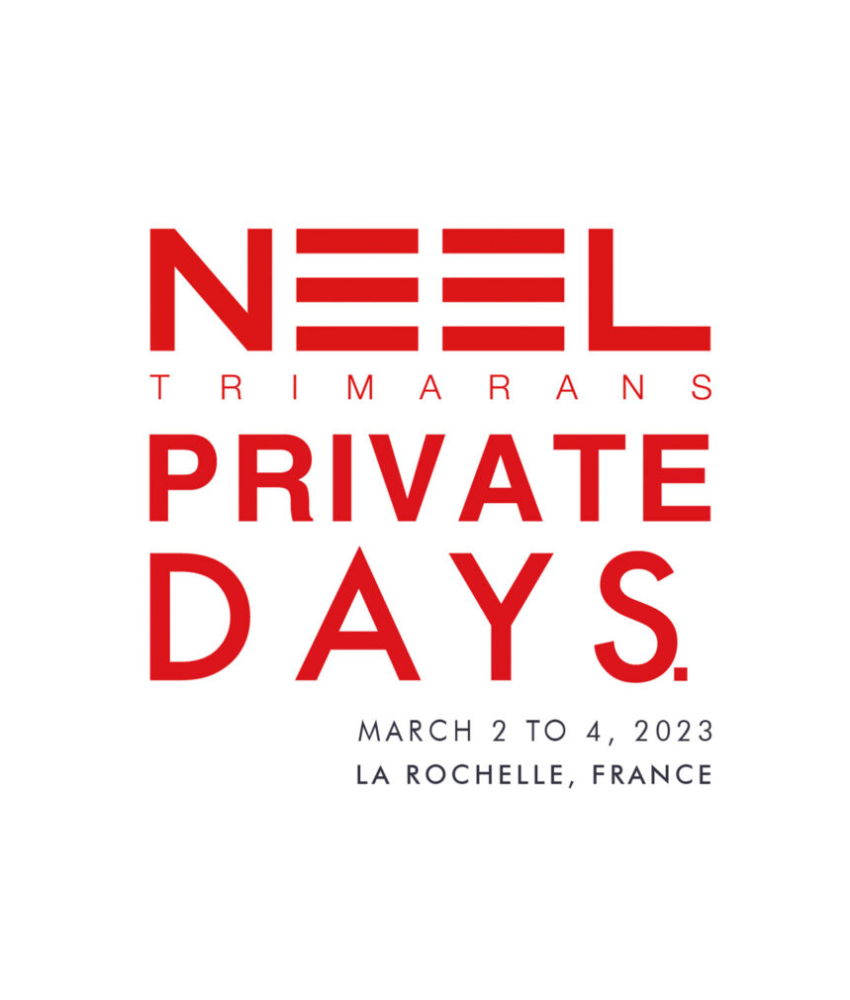
NEEL-TRIMARANS and its dealer network are organising the PRIVATE DAYS in La Rochelle from March 2, to March 4, 2023
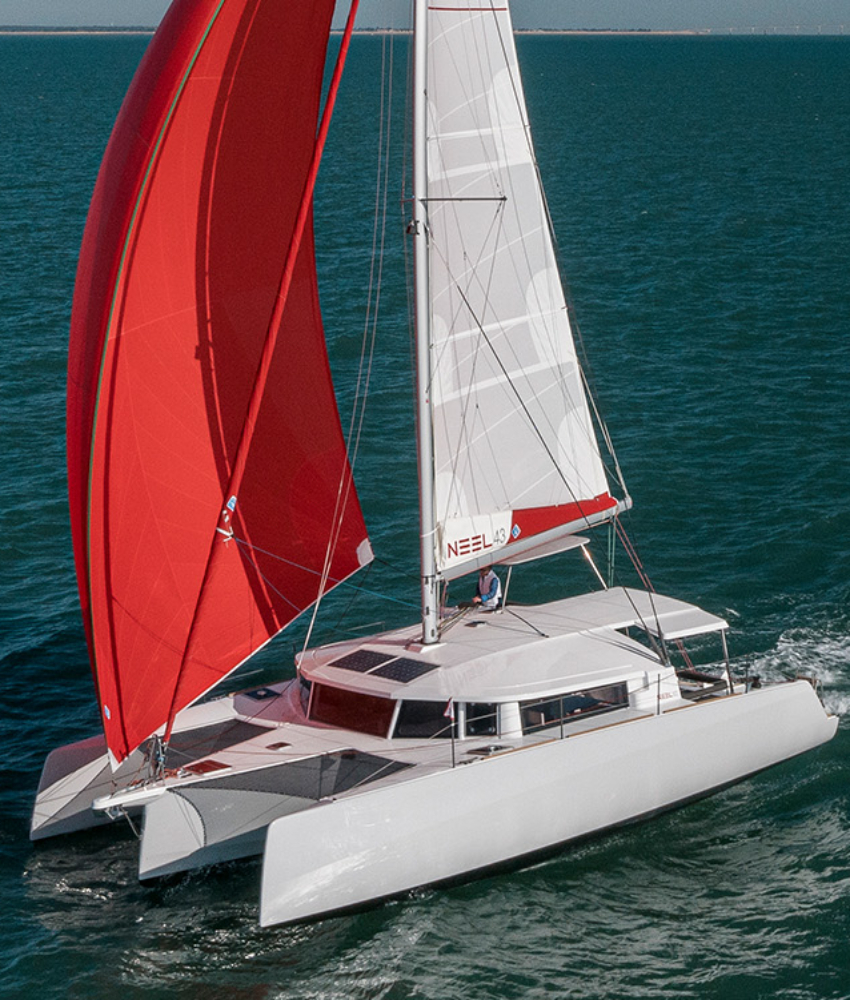
NEEL 43 elected among the top 10 boats of 2023 by SAIL Magazine

The latest Lombard-designed addition to the range is even more innovative and impressive, and with a marked move towards the use of bio-sourced and recyclable materials. The NEEL 43 is available in a limited edition performance version.
The neel 47 successfully combines the benefits of cruising or blue water yacht : safety, performance and comfort living..
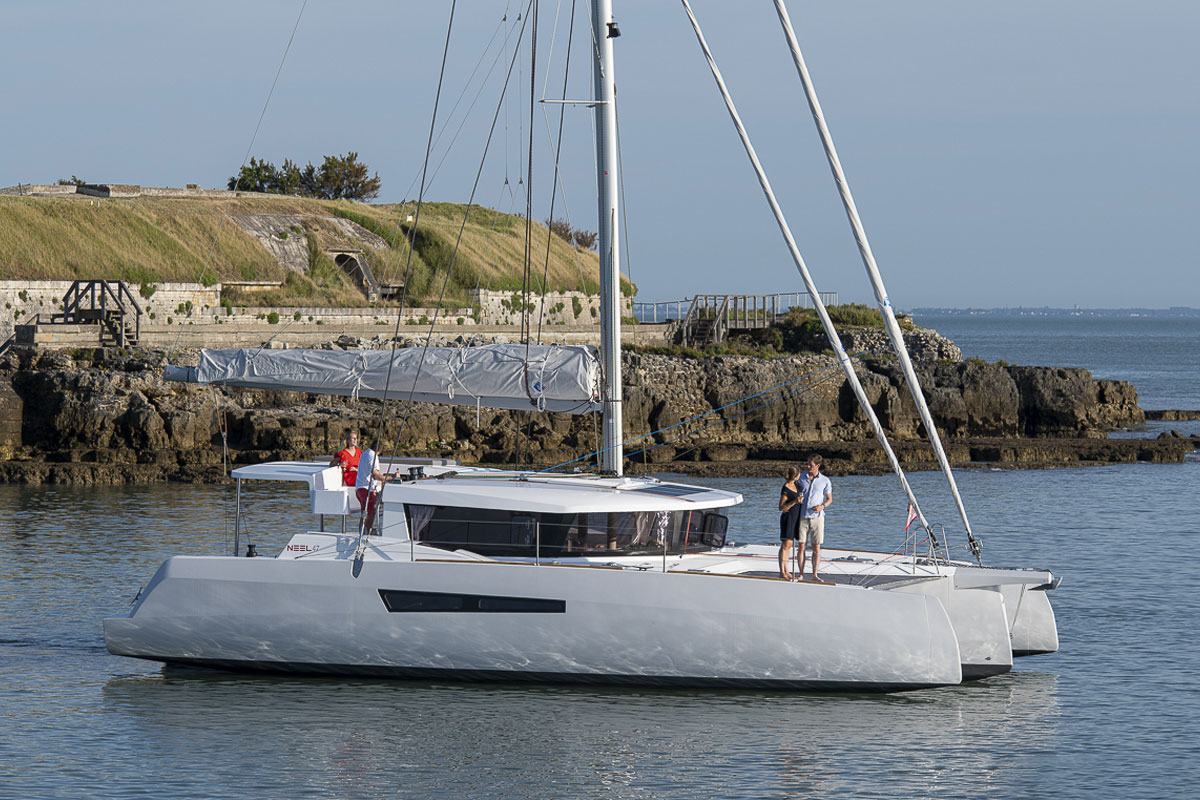
With its racy, modern silhouette, elaborately designed hull and sleek lines, the NEEL 52 exudes power, speed, and elegance. Moving inside and on the deck is smooth and safe.
The neel 65 evolution, the flagship of the fleet, offers unequalled comfort and navigation in "sport-chic" mode..

Privacy Overview
- Legal Notice
- Recruitment
- Private access

IMAGES
VIDEO
COMMENTS
But if you're content to sail in the speed range indicated by the table, which is surprisingly broad, and can accept the other compromises, there's definitely a case for using the box hulls and keeping it simple. Outside of that, expect speeds at around 10% slower at the low end and similar at the much higher end beyond SLR of 3.5. Of course ...
Doing that resulted in a not-terrible boat speed of 5-6 knots and a good pointing angle. Free off by a handful of degrees however, and ease the sails just a smidge, and the speed leapt up to 8-9 knots - over 50% more; a huge increase. So, don't pinch.
The word "trimaran" is a portmanteau of "tri" and "(cata)maran", [3] a term that is thought to have been coined by Victor Tchetchet, a pioneering, Ukrainian-born modern multihull designer. [4] Trimarans consist of a main hull connected to outrigger floats on either side by a crossbeam, wing, or other form of superstructure—the traditional Polynesian terms for the hull, each float and ...
V=sqrt (g x Wavelength / (2 PI)) (g is gravitational constant 9.8m/s/s) A long slender hull has relatively low wave drag compared with viscous drag so the notion of hull speed does not apply. The detail provided so far gives you a starting point for a design. Maximum length 20ft. Overall beam 8ft.
The central hull is just over 59 feet long with amas (or outer hulls) on either side that make the total beam nearly 39 feet. It's like a nearly-square speed demon with training wheels. Above: The Rapido 60 Trimaran Sailing Yacht's hull is sleek and sporty design for performance while still being a comfortable long range bluewater cruiser.
For those seeking speed and excitement, high-performance tri-hull boats are the way to go. One example is the Farrier F22 Trimaran, a versatile, compact sailboat that comes in three series: the F-22, F-22S, and F-22R. These series are categorized as standard, standard premium, and premium models, respectively.
An unusual, but appealing, feature of all Neel trimarans is the technical area below the saloon floor in the central hull - on some of the larger models this has an impressive 7ft (2.1m) of ...
On a trimaran, the forestay, mast and mainsail tension are structurally bonded to one strong, longitudinal beam : the main hull. This configuration, as per a monohull, allows for a rigid forestay and good performance up-wind. Performance is also enhanced by the centered weight. The extra speed of the trimaran is an additional safety factor.
At the other end of the scale the resistance curve is fairly flat up to about 1:9 which is still quite fast in most conditions. From there the resistance rises steeply as the hull gets fatter and at 1:8 and fatter you're suffering from some serious form drag. This is the rocker line isolated from the lines plan above (in blue) and and the red ...
Hull Type: Trimaran with fixed unballasted keel: Rigging Type: Fractional Sloop: LOA: 43.00 ft / 13.11 m: ... Hull Speed: The maximum speed of a displacement hull (referring to a hull that travels through the water rather than on top of it, e.g. planing). HS = 1.34 x √LWL (in feet)
The 2019 Weta trimaran is a 14.5-foot (4.4-meter) trimaran featuring a carbon frame, centerboard, rudder foil, and rudder shock. The hull is made from fiberglass and foam. The Weta is built for strength and speed based on these lightweight materials.
This review is dedicated to the unique three-hull yacht Neel 43 trimaran, ... The maximum speed of the Neel 43 trimaran depends on various factors such as wind conditions, sea state, sail configuration, and the weight of the vessel, crew, and equipment. However, the manufacturer states that the Neel 43 has a maximum speed of around 20 knots (23 ...
As shown in Fig. 6, the resistance curve of the trimaran planing hull is similar to that of a seaplane in the first three phases of taking-off, as both of them have two drag humps [21]. But the drag humps of the trimaran planing hull are more distinct. The model speed when drag hump appears in different tests is shown in Tab. 3. Tab. 3.
This remarkable sailing trimaran stands out with its new innovative wave-piercing main hull design, ensuring smooth and efficient sailing. With a strong emphasis on easy handling and shorthanded sailing, the DRAGONFLY 36 is perfect for families and sailing enthusiasts alike.Step aboard and experience the spacious cockpit that invites relaxation and social interaction, complemented by a stylish ...
A trimaran is a multihull vessel designed to reduce wave-making resistances at high speeds. Optimization of the hull shape increases hull efficiency and speed of a vessel. The behavior of a ship is generally analyzed through numerical methods to save time and reduce high expenditures as compared to experimental methods. Although wide ranges of studies have investigated the hydrodynamic ...
With three hulls instead of two, trimarans like the Corsair 880 and Rapido Trimaran have a wider beam, which can help increase speed and stability in high winds. Additionally, trimaran sailing techniques can differ from those used on catamarans due to the placement of the centerboard and the differences in the hull shape.
It deals with a high speed trimaran hull suitable for medium range routes and intends to analyze the hydrodynamic behaviour and the interference effects in different configurations and with two different forms for the main hull: a round bilge and a deep-V hull. The paper is concerned with the ship resis-tance, which, in addition to the results ...
However some two trimaran hull forms for high speed transportation: one with round useful examples have been reported (Ackers, 1997). Some research has bilge component hulls and one characterized by a hard-chine main hull. also been carried out by the research group of the authors (Brizzolara The experimental data concern residual resistance ...
As noted above, the Froude Speed/Length ratio is very significant in boat design. Most descriptions and findings re hull resistance are directly related to it. For example it has been shown that a displacement hull creates a wave equal to its length at a S/L ratio of 1.34 and at that point, there's such a hump in the resistant curve that most ...
The trimaran hull also exhibits low hydrodynamic drag, allowing efficient operation on two diesel-powered water jets at speeds up to 18 knots (33 km/h; ... The design for Independence is based on a high-speed trimaran (Benchijigua Express) hull built by Austal (Henderson, Australia). The 418-foot (127 m) surface combatant design requires a crew ...
Hull Speed: The maximum speed of a displacement hull (referring to a hull that travels through the water rather than on top of it, e.g. planing). HS = 1.34 x √LWL (in feet) Pounds per Inch Immersion: The weight required to sink the yacht one inch. Calculated by multiplying the LWL area by 5.333 for sea water or 5.2 for fresh water.
Additionally, Weija et al. (2013) have investigated a high-speed trimaran planing hull to examine the characteristic of the resistance and hull form; the ship model has been tested in order to ...
ABSTRACT. This paper presents experimental data and numerical computations for two trimaran hull forms for high speed transportation: one with round bilge component hulls and one characterized by a hard-chine main hull. The experimental data concern residual resistance results systematically collected for a grid of configurations of both hull forms. The numerical analysis, carried out on the ...
A NEEL trimaran, the perfect sailing boat for an unforgettable adventure. NEEL-TRIMARANS and its dealer network are organising the PRIVATE DAYS in La Rochelle from March 2, to March 4, 2023. NEEL 43 elected among the top 10 boats of 2023 by SAIL Magazine. The latest Lombard-designed addition to the range is even more innovative and impressive ...